what did we learn from SA’s Five years on:
BLACKOUT?
QLD’s green power hub makes headway

Kurri Kurri gas plant: why the controversy?

ISSUE 15 · September 2021 · www.energymagazine.com.au
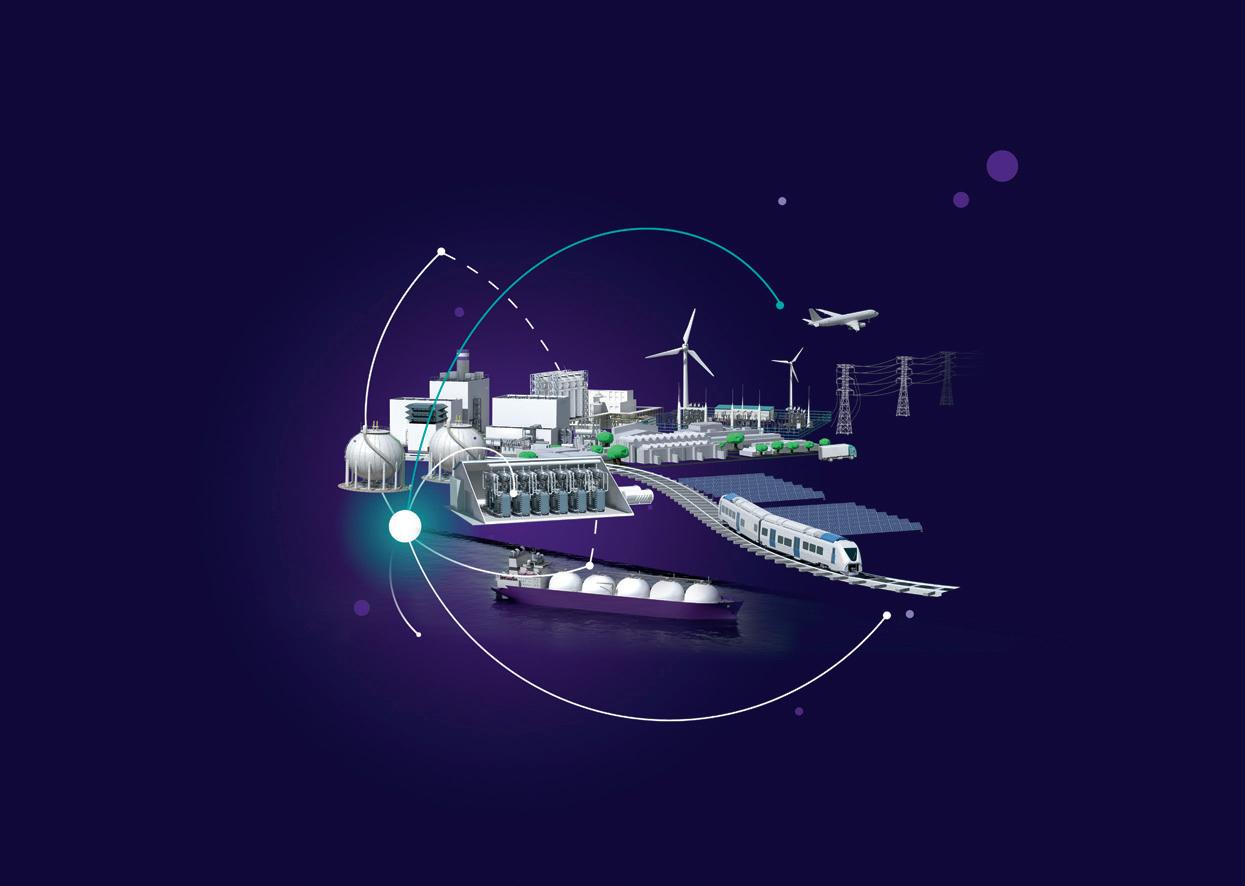
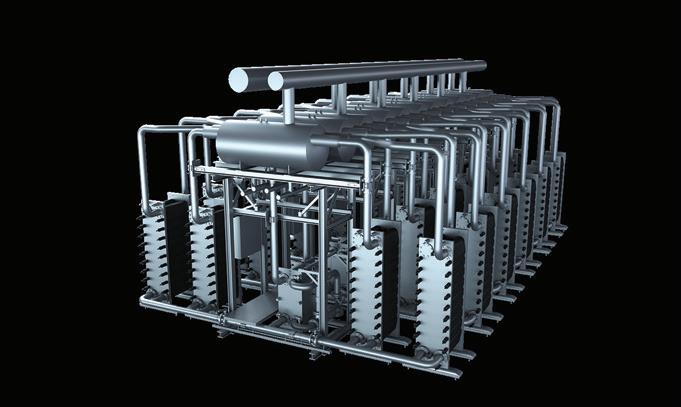
For more information, scan the QR code


What a difference a few months can make in between writing an Editor’s Welcome.
When I wrote my last welcome, I had just returned from a trip to Sydney, where a visit to a large-scale energy industry event had left me feeling excited about the upcoming opportunities for the sector.
Only a few weeks later, Sydney’s lockdown began, and a number of other lockdowns around the country have also been and gone since then.

transition that is currently underway in the world of energy.
P: (03) 9988 4950
F: (03) 8456 6720
monkeymedia.com.au
info@monkeymedia.com.au
energymagazine.com.au
We’re fortunate as members of the energy industry to be essential workers for whom the show must go on. But over the last couple of months, I’ve had many conversations with members of the industry – particularly those based in Sydney –about how to best manage the challenges of remote working. As a Melburnian, I know all too well how hard it can be to maintain a level of intensity and focus when working from home, but 18 months into this gig, I have a few tips which I’ve come to rely on.
Firstly, each day I write a list of five things I’d like to achieve professionally each day. They don’t always get achieved, but they help to provide focus.
Secondly, I try to schedule meetings at times when I know I often feel flat (10.30am and 1.30pm, for the record!) as a way to pep me up and push me through the day.
Imogen has written many brilliant features for the magazine over her time with the magazine, and this issue features perhaps her best piece yet – a deep dive into the system black event in South Australia in 2016, which is still regularly discussed and dissected across the industry.
This article is the first in a multi-part series which will cover the event, and will analyse not just what went wrong, but importantly, what we as an industry have learned, and can continue to learn from this event. I encourage you to give the article a read.
Laura Harvey Editor
Christopher Allan
Lauren DeLorenzo
Jacqueline Buckmaster
Thirdly, I try to focus on my most challenging tasks in the morning, and leave the work that I really enjoy doing for the afternoon.
Something that I really enjoy doing is mentoring members of my team, and that brings me to the second part of my Editor’s Welcome of this issue.
This is actually the last issue of Energy that I will be editing. Fortunately, I’ll still be staying on as Managing Editor of Energy, so it’s not really goodbye; and I’m thrilled to let you know that Energy’s current Associate Editor, Imogen Hartmann, will be moving into the Editor’s chair.
Imogen has been working with me on Energy for almost two years now, and she shares my passion for the industry, and the

1
you’d like to get in
new
you can reach Imogen at imogen.hartmann@monkeymedia.net.au ISSUE 15—SEPTEMBER 2021 WELCOME EDITOR’S WELCOME The 1P Tracker by Soltec PATENT PENDING www.energymagazine.com.au BLACKOUT? what did we learn from SA’s Five years on: Kurri Kurri gas plant: why the controversy? QLD’s green power hub makes headway
Media
If
touch with Energy’s
Editor,
Monkey
Enterprises ABN: 36 426 734 954 C/- The Commons, Office 1, 36–38 Gipps St, Collingwood VIC 3066
by We’re keen to hear your thoughts and feedback on this issue of Energy. Get in touch at info@energymagazine.com.au or feel free to give us a call on (03) 9988 4950. September 2021 ISSUE 15 Editor
Editor
info@energymagazine.com.au ISSN: 2209-0541 Published
Laura Harvey Associate
Imogen Hartmann Journalists
April Shepherd
Annabelle Powell Design Manager
Alejandro Molano Designers
Danielle Harris National Media and Events Executives
Rima Munafo Brett Thompson Marketing Manager
Radhika Sud Client Services Manager Stephanie Di Paola Publisher Chris Bland Cover highlights a major feature in this issue, an in-depth look at the 2016 South Australian blackout, using five years worth of hindsight to determine what went wrong, and what the industry learnt from the incident.


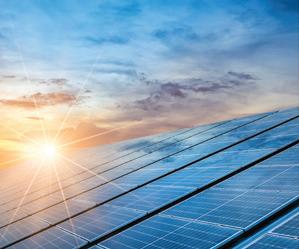

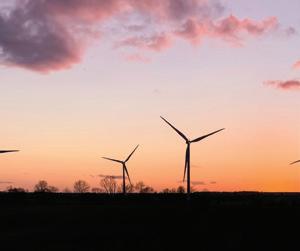

2 FUTURE ENERGY 14 And they’re off: the state race to network regions of renewables 18 Bioenergy investment to support Australia’s path to net zero 20 Victoria's gas infrastructure: what does the future hold? 22 It’s dark, it’s still – it’s dunkelflaute FUTURE ENERGY 24 National modelling data to help electricity sector plan around climate risk 26 Gearing up for the energy storage era 28 Zenaji Aeon Battery passes all Australian tests WIND 30 Kaban Green Power Hub gives QLD's renewable efforts a second wind 32 Enhance your turbine maintenance with the best service tools INDUSTRY INSIGHT 10 Examining the Kurri Kurri gas plant controversy 14 24 10 NEWS 4 EnergyAustralia’s potential pumped hydro facility 6 DER two-way market trial moves to next phase 6 AGL demerger creates two new businesses 8 Aurora Energy appoints new metering service provider 9 Australia’s largest gas and coal export partner slashes demand EACH ISSUE 1 EDITOR'S WELCOME 64 FEATURES SCHEDULE 64 ADVERTISERS’ INDEX CONTENTS September 2021 ISSUE 15 www.energymagazine.com.au


GAS PIPELINES
34 The role of gas pipelines in Australia’s future energy system
36 Delivering the future of gas through Australia’s most comprehensive green hydrogen demonstration 34

38

ENERGY EFFICIENCY
38 Room for improvement: Australia and Germany swap notes on energy efficiency reform
40 Why energy storage is an essential part of a smart electric grid
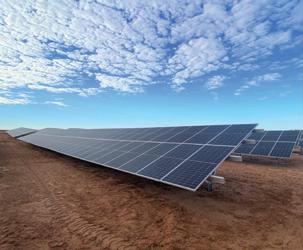
42

42 Australia’s first green hydrogen plant in a remote power system
44 Mitigating the risks of remote workplaces


DISASTER MANAGEMENT
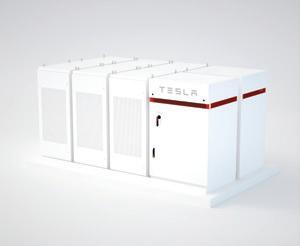
62 Powercor tests new drone tech for powerline checks 46 52 62
46 Black system or black swan: learnings from South Australia’s infamous 2016 blackout
50 New technology transforms resiliency readiness

DISTRIBUTED GENERATION
52 Powering ahead with community batteries
56 Technology not taxes: the problem with technology-led energy futures
58 Deploying SPS for WA’s Cyclone Seroja recovery and beyond


60 How distribution businesses should embrace the transition DRONES
CONTENTS 3
REMOTE POWER
www.energymagazine.com.au September 2021 ISSUE 15
ENERGYAUSTRALIA’S POTENTIAL PUMPED HYDRO FACILITY
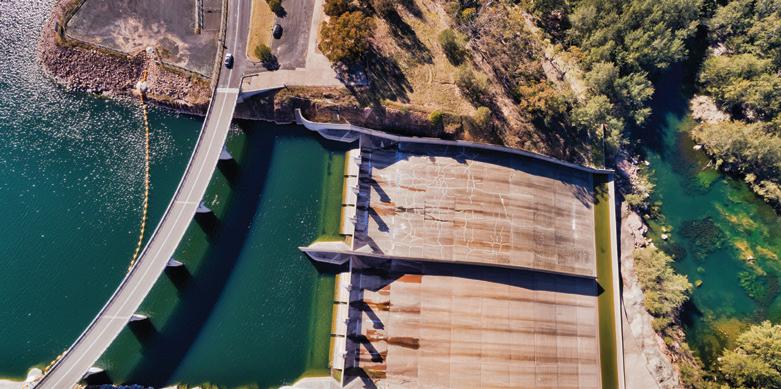

EnergyAustralia has revealed a new potential pumped hydro energy storage facility, to be located at the Lake Lyell dam – which supplies water to Mt Piper power station in Lithgow, NSW.
Energy Executive, Liz Westcott, said early estimates suggest a Lake Lyell pumped hydro energy storage facility would be capable of producing 350MW of electricity, with around eight hours of storage –enough to power approximately 150,000 households during peak demand.
“Initial studies show that a Lake Lyell pumped hydro energy storage facility has enormous potential to become a major piece of infrastructure for New South Wales in a transitioning energy system,” Ms Westcott said.
“Pumped hydro will continue to play an important role in providing reliable, affordable and cleaner power for homes and businesses into the future. One of the benefits of Lake Lyell is that it’s already located near major transmission lines."
Lake Lyell would be used as a lower reservoir and the upper reservoir would be located on the south side of Mt Walker, all on land owned by EnergyAustralia.
Head of Mt Piper, Greg McIntyre, said the facility would provide a welcome economic boost for the region and support Lithgow in becoming a future renewable energy hub.
“A new pumped hydro facility at Lake Lyell would ensure Lithgow’s legacy in energy generation is preserved well into the future,” Mr McIntyre said.
“If the project goes ahead, we anticipate hundreds of jobs would be created during construction, with roles also needed to oversee the facility’s ongoing operation.
“Detailed assessments will follow, including environmental impacts and planning approvals, before any firm decisions can be made; however, the first step is consulting with our community.”

NEWS 4 September 2021 ISSUE 15 www.energymagazine.com.au
COUNCIL MAGAZINE
your leading source of news for the local government sector
Council has been developed to keep you up-to-date with all of the latest news, discussions, innovation and projects in the local government sector.


Council is fully integrated across print and online, featuring a website updated daily with the latest industry news, a weekly e-newsletter delivered direct to your inbox, and a quarterly magazine that can be read in print and online.
Published by industry publishing experts Monkey Media, Council will arm community decision-makers with the critical information they need to deliver a better future for cities, towns and suburbs all over Australia.




HEAD TO THE WEBSITE TODAY to sign up for the FREE WEEKLY NEWSLETTER!


www.councilmagazine.com.au
info@councilmagazine.com.au
DER TWO-WAY MARKET TRIAL MOVES TO NEXT PHASE

AEMO, AusNet Services and Mondo have completed the first phase of a world-first trial to create a two-way market for distributed energy resources (DER).
The trial seeks to enable consumers to benefit from their DER participating in the National Electricity Market (NEM).
Project Energy Demand and Generation Exchange (EDGE) will run an off-market platform for eligible customers in north-east Victoria to trade electricity and grid services via an aggregator or Virtual Power Plant (VPP) operator from their DER, such as rooftop solar and batteries, similar to large-scale participants in the NEM.
AEMO’s Principal Analyst Member Services, Matt Armitage, said, “Project EDGE aims to build understanding of and inform the most efficient and sustainable way to integrate DER into the electricity system and markets, allowing all consumers to benefit from a future with high levels of DER.”
Since the inception of the project in November 2020, the partners have been working together to engage heavily with industry to define the research questions
Project EDGE will seek to answer and shape the project’s DER Marketplace design.
With Phase 1 of the project completed, AEMO has published a ‘lessons learned’ report on behalf of the project partners covering progress to date.
The project partners have established EDGE-specific stakeholder forums relevant to their respective roles.
AEMO is progressing the development of the EDGE marketplace with high-level design requirements established; AusNet Services similarly is progressing the build of the DSO platform that will integrate with the EDGE marketplace.
Mondo has commenced work on enhancing their UBI aggregation platform and behind the meter (BTM) technology to meet EDGE requirements.
Project EDGE has moved into Phase 2, which primarily focuses on establishing the marketplace minimum viable product (MVP) in preparation for DER to commence delivering wholesale and local network services and required data exchange infrastructure.
The project is on track for the planned commencement of off-line trials in November 2021 followed by operational trials in May 2022.
AGL DEMERGER CREATES TWO NEW BUSINESSES
AGL has confirmed details of its demerger, with the business to split into two new entities – Accel Energy and AGL Australia.
Accel Energy (previously referred to as PrimeCo) will be the new home for AGL’s coal and gas-fired power plants. AGL Australia meanwhile will focus on retail, flexible energy trading, energy storage and supply.
Graeme Hunt, the current Interim Managing Director and CEO of AGL Energy, will be the Managing Director and CEO of Accel Energy.
Mr Hunt will be in charge of the company’s coal and gas power plant fleet, under Accel Energy.
AGL Australia will be led by Christine Corbett, who will be the Managing Director and CEO.
AGL Energy Chairman Peter Botten said, “The impact of recent challenging market conditions on our financial performance emphasises that AGL Energy is now at an inflection point, as the transition of the energy sector accelerates, driven by the rapid evolution in renewables and decentralised energy technology, customer needs and community expectations.
“For Accel Energy, this means focusing on the transition of its existing electricity generation assets and investment in the longterm rejuvenation of its valuable operating sites as low-carbon industrial energy hubs, as well as new clean energy projects.
“For AGL Australia, it means focusing on being Australia’s leading two multi-product energy retailing business while investing
in flexible energy trading, storage, supply and decentralised energy services.”
AGL Energy shareholders will hold one share in each of Accel Energy and AGL Australia for every share they own in AGL Energy on the applicable record date.
Mr Hunt said that AGL Energy has received strong financing commitments from its banking group and new lenders, establishing independent borrowing facilities for both Accel Energy and AGL Australia.
AGL Energy intends to hold a scheme and general meeting to enable shareholders to vote on the proposal and to complete the demerger in the fourth quarter of FY22, subject to final AGL Energy Board, ATO and relevant regulatory, court and shareholder approvals.

NEWS 6 September 2021 ISSUE 15 www.energymagazine.com.au
We power up your health
so you can power up Australia
Did you know there’s a health fund specifically for people working in the energy sector? One that understands the job you do and your industry’s particular health issues. rt health is your industry health fund and is here to power up your health care needs.
1300
www.rthealthfund.com.au
886 123
AURORA ENERGY APPOINTS NEW METERING SERVICE PROVIDER

Aurora Energy has announced a new long-term partnership to fulfill its metering coordination to deliver advanced metering services to residential and small business customers across Tasmania.
TasMetering will replace Yurika as Aurora’s appointed metering coordinator.
TasMetering is headquartered in Hobart and is a Tasmanian focused operation of the Intellihub Group.
Advanced meters are the next generation of electricity meters and offer many more benefits than older style basic meters, including remote reading and an end to estimated bills, monthly billing and help to facilitate new home energy services in the future.
The announcement complements the Tasmanian Government’s election commitment to accelerate the roll out of advanced meters to all Tasmanians by 2026.
TasMetering CEO, Jon Bruschi, said the business would bring an experienced, reliable and customer focused service to Tasmanian homes and businesses.
“We’re focused on delivering outstanding customer service to Aurora Energy and its customers,” Mr Bruschi said.
“We’re aiming to set a new benchmark in quality metering, and we will be bringing the best technology to showcase right here in Tasmania.
“This includes advanced digital tools for customers to schedule, track and give feedback on our service.”
Aurora CEO, Rebecca Kardos, said advanced meters facilitate the development of modern products that empower customers to lower their energy costs.
“When paired with digital or other energy products that provide the metering data in a user friendly and informative way, advanced meters enable Tasmanians to make more informed choices about how and when they use electricity,” Mrs Kardos said.
“Being aware of your power use is an important energy saving tip. Knowing when and how much energy you’re using can help Tasmanians save money.”
Aurora said there is no upfront cost for a customer to have an advanced meter installed in the majority of situations unless works are required to upgrade existing infrastructure to meet current metering specifications and safety standards.
8 September 2021 ISSUE 15 www.energymagazine.com.au
NEWS
AUSTRALIA’S LARGEST GAS AND COAL EXPORT PARTNER SLASHES DEMAND
Japan, Australia’s largest thermal coal and gas buyer, has announced a switch to renewables – with the goal of doubling its renewable energy target for 2030 and halving its gas usage, slashing demand for Australian LNG and coal.
The changes were announced by Japan, which currently buys 67 per cent of its thermal coal and 39 per cent of its LNG from Australia, in a draft report from Japan’s Ministry of Economy, Trade and Industry.
The revised figures laid out in the draft plan state that renewables should account for 36-38 percent of power supply in 2030, double the 18 percent level in March 2020.
These changes have created turbulence in the Australian LNG and coal industry –especially as the Federal Government has
hailed gas as a key part of the country’s COVID-19 recovery and continues to invest in the industry, recently committing $224 million in funding to develop an onshore gas field in the Northern Territory Beetaloo Basin.
Japan’s choice shows a worldwide energy reset, moving away from fossil fuels and turning to renewables, to combat climate change.
Greens Leader, Adam Bandt, said, “This year, about 40 per cent of Australia’s gas and thermal coal exports have gone to Japan.
“This one decision from Japan alone could end close to 20 per cent of Australia’s thermal coal exports within a decade, and with China and Korea also committing to net-zero emissions, the industry could soon collapse.”
Mr Bandt said that the Federal Government must massively ramp up investment in manufacturing and green energy in Queensland and NSW to guarantee secure jobs after 2030, and that the Beetaloo gas fields in the Northern Territory developments should be halted.
“Opening up new gas fields isn’t just a climate crime, it’s an economic disaster,” Mr Bandt said.
Dr Madeline Taylor, Climate Councillor and energy expert, said that Australia could be generating and exporting renewable energy to meet rising global demand.
“The government must accelerate progress towards a renewables-powered economy instead,” Ms Taylor said.
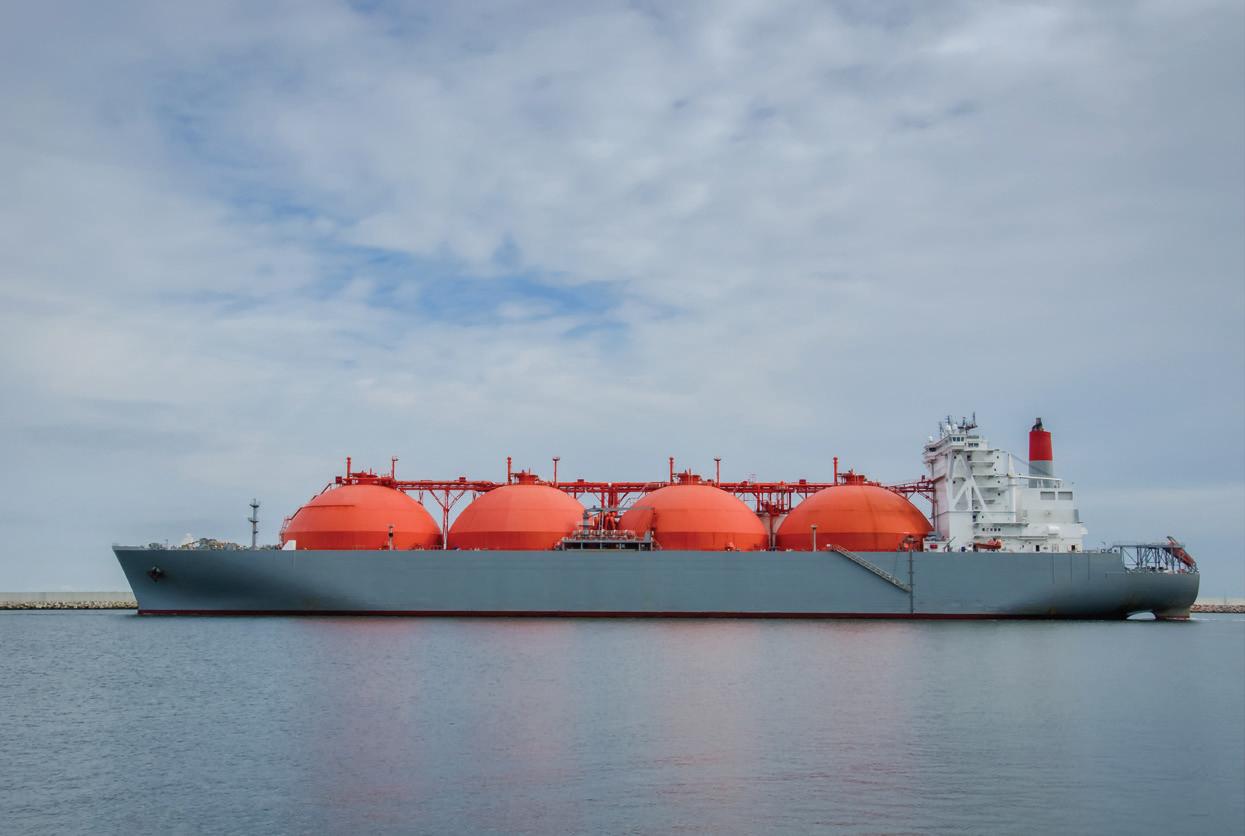
9 www.energymagazine.com.au September 2021 ISSUE 15
NEWS
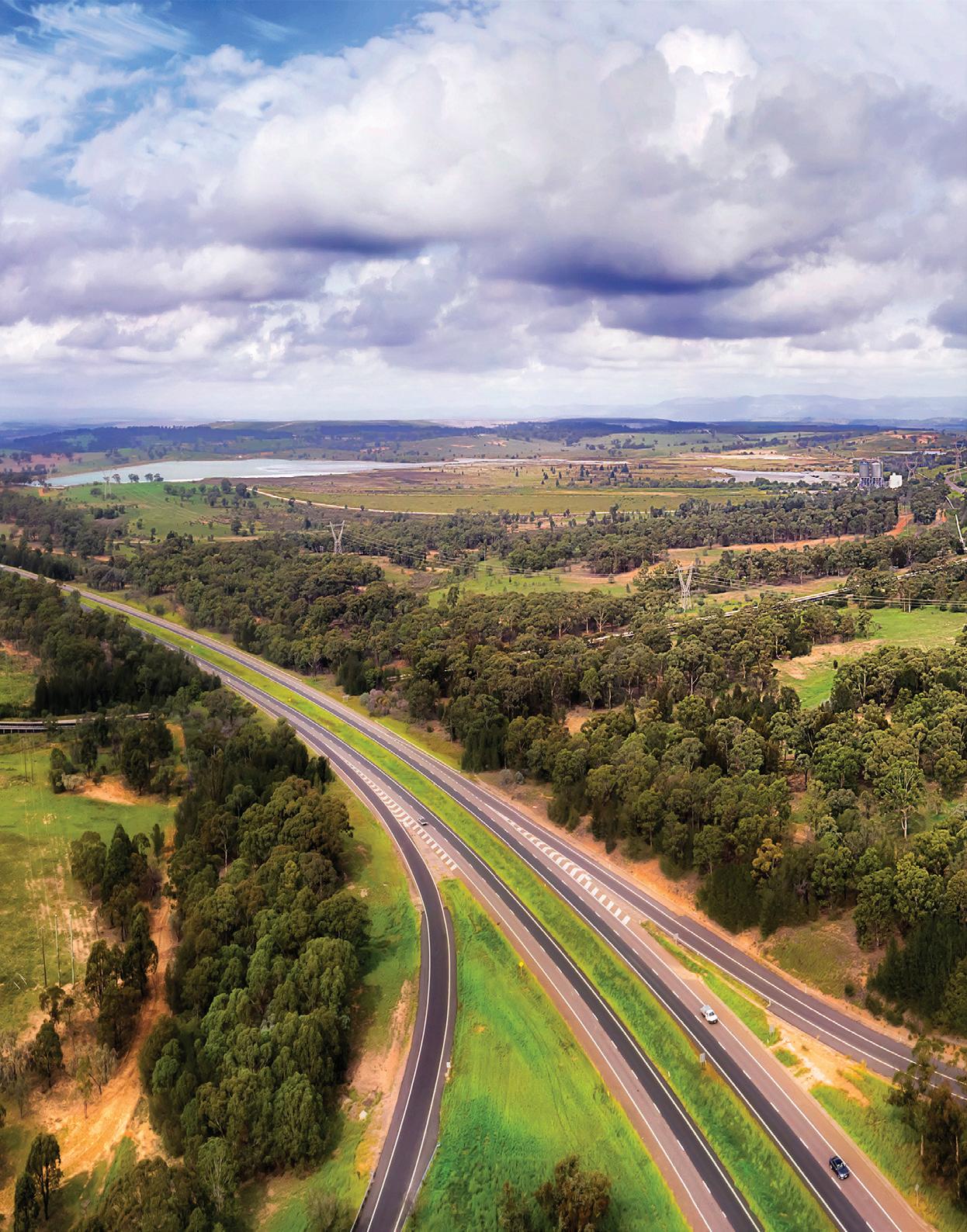
EXAMINING THE KURRI KURRI GAS PLANT CONTROVERSY
by Imogen Hartmann, Associate Editor, Energy magazine
The Federal Government has confirmed its decision to build the Hunter Power Project, a publicly-funded gas plant in Kurri Kurri aimed at replacing electricity supply lost from the upcoming retirement of the Liddell Power Station. The plans for the gas plant – seen by many as a backwards step in our transitioning energy market – and the spending of public funds to cover it, has come under criticism from the industry. Here, we talk to Dr Ross Gawler, Senior Research Fellow, Department of Data Science & AI, Faculty of IT, Monash Energy Institute, about the Government’s plans, which he warns will create a cost to electricity consumers that is too great to justify its means.
September 2021 ISSUE 15 www.energymagazine.com.au
10 INDUSTRY INSIGHT

www.energymagazine.com.au September 2021 ISSUE 15 11 INDUSTRY INSIGHT
n September 2020, the Federal Government issued an ultimatum to Australia’s energy industry – deliver 1000MW of new dispatchable energy to replace the Liddell Power Station before it closes, or the Government would do it themselves. The Government’s cut off for an industry-led project was April 2021, and with no projects put forward, the Government announced the controversial Kurri Kurri gas plant in May 2021.
The Federal Government confirmed a $600 million-spend on the build of the new gas-fired power station in Kurri Kurri in the New South Wales Hunter Valley. The 660MW power plant, run by Snowy Hydro, will comprise two heavy-duty, open cycle gas turbines (OCGT).
Operating on natural gas, the OCGTs will also be hydrogenready, with diesel on hand as back-up for the extreme circumstances where the grid needs support. Snowy Hydro says the OCGTs will have the capability to run initially on up to 10 per cent hydrogen, but with “minor additional investment”, that number could jump up to 30 per cent, subject to fuel logistics.
The Federal Government is adamant that having electricity sources that can produce ‘on-demand’ or dispatchable energy are critical as large coal-fired power stations retire and we transition to renewable energy sources like wind and solar power. According to the Federal Government, the Hunter Power Project at Kurri Kurri is set to “fill the gap” in electricity demand in the wake of the Liddell Power Station’s retirement.
Rising electricity costs
In 2020, when the Government first issued its ultimatum, the Liddell Taskforce found closing the plant without adequate dispatchable replacement capacity would risk prices rising by around 30 per cent over two years, or $20 per MWh to $80 in 2024 and up to $105 per MWh by 2030.
However, Dr Gawler argues that instead of providing a cost effective solution to the ensuing price rises, the gas plant could potentially result in even more of a rise in electricity costs, although it may slightly lower bills to consumers. This is because of the displacement of a “more efficient combination of new electricity generation resources, which would offer lower costs”.
Dr Gawler said that there could be a slight decrease in electricity prices as a result of the surplus created by building the gas plant as proposed. However, Dr Gawler said his original analysis had assumed the plant would run on gas. This may not be the case, instead the proposed plant is a peaker plant, meaning it would run on liquid fuel – which is even more expensive than gas. Dr Gawler said it is this discrepancy between the Government’s plan and his original analysis that could mean an even more expensive result.
“A combination of increasing electricity costs and decreasing prices means that other generators’ profits would be reduced by the project for a time,” Dr Gawler said.
“This will be reflected in a loss of income to the Federal Government through its earnings from Snowy Hydro, as well as Australians whose superannuation funds have invested in Australian electricity companies (such as AGL).
“So, if we did get lower electricity bills from the project, our taxes will not fall but may rise to compensate – or Government services will need to be cut to match the lower tax and dividend income of the Government.”
Dr Gawler's colleague, Associate Professor Ariel Liebman, said, “The investment of gas-fired power would also increase total electricity costs by about $70 million per year, with total system costs over the period to 2043 increased by up to $1.011 million.
“Moreover, this project would reduce the Snowy Hydro net profit by up to $3.380 million over this same period.”
Greener alternatives on hand
New South Wales currently has a target of net zero emissions by 2050 – pioneering as one of the first jurisdictions in the world to set a net zero objective. According to Professor Liebman, the Hunter Power Project would increase carbon dioxide emissions by five million metric tonnes of CO2 over 20 years to 2042/43.
Dr Gawler said this means that carbon offsets would have to be purchased elsewhere to cancel out the emissions from the project.
“That would be yet an additional cost burden on the NSW community,” Dr Gawler said.
Alternatively, Dr Gawler says that the plant could be run on green hydrogen with no material increase in emissions. He also said that renewable storage solutions, like pumped hydro or batteries, would provide a sensible solution for the longer-term outlook.
“Pumped hydro has the advantage of providing longer-term storage than batteries, albeit at slightly lower cycle efficiency than batteries,” Dr Gawler said. “It can be used to store the surplus renewable energy available in summer and make it available for winter when wind and solar yield is generally lower. Cross-seasonal storage is really needed to get the best out of our renewable resources.”
Professor Liebman echoed his sentiments. “If the Federal Government were to drop this project altogether, an alternative option would be to generate power through the development of off-river pumped hydro energy storage (PHES), as included in the AEMO 2020 Integrated System Plan (ISP) modelled investment options.”
“Battery storage would just as well serve the low duty expected from the gas turbine power plant, and indeed AGL and EnergyAustralia are pursuing utility-scale battery projects for this reason,” Dr Gawler said.
“It also helps to make better use of their purchased solar and wind resources and enables them to lower their carbon emission profile.”
The hydrogen-gas conundrum
Dr Gawler said low-cost hydrogen fuel can be an option in gas turbine plants that are designed to accommodate it. In this case, and when sourced from renewable energy, hydrogen can act as the back-up for a variety of energy sources without adding carbon emissions. However, this is only effective when the hydrogen can be delivered to site via carbon-free transportation (such as pipeline or tankers/trains using hydrogen fuel).

I
12 INDUSTRY INSIGHT
“At the moment, bulk hydrogen costs more than liquid fuel and natural gas, so it cannot compete commercially for power generation in the absence of a carbon price,” Dr Gawler said.
“Development of large-scale electrolytic processes for producing hydrogen from water using spare renewable energy is needed.
“Carbon pricing would create a commercial incentive for this transformation. There is little incentive at the moment.”
“There is no doubt that gas turbine technology powered by green hydrogen could play a role in the transition to zero carbon,” Professor Liebman said.
“However, based on the current data for the expected improvement of performance and the costs of alternative technology, there is no overall economic basis for the Federal Government’s proposal for a new gas turbine power station in the absence of low-cost hydrogen fuel.”
Dr Gawler said there are four themes at play in order to encourage investment in the development of a hydrogen industry, as opposed to more investment in gas. These are:
1. Establishing carbon pricing to value the emission abatement benefits of green hydrogen
2. Providing funds for research and development of the hydrogen economy to supplement the above
3. Developing an infrastructure plan that will enable Australia to eventually export green hydrogen at least cost
4. Discouraging the further development of natural gas producing fields with a plan to convert gas pipelines to hydrogen over time
Industry exhausted with federal intervention
According to Dr Gawler, many in the energy industry are not on board with the project, and are concerned that it may discourage or delay efficient developments in the sector as a result of market intervention.
The Clean Energy Council said the Federal Government’s build of a new gas-fired power station in New South Wales is “reckless and undermines Australia's efforts to deliver lower-cost power, reduce emissions and build a reliable energy system”.
Clean Energy Council Chief Executive, Kane Thornton, said, "Government intervention to directly build their own high-cost generation is not only a poor use of taxpayer funds but also further undermines investor confidence in the new generation.
“In the Clean Energy Council's most recent survey of CEOs of Australia's leading renewable energy investors, after challenges with the grid, 'Unpredictable or unhelpful government intervention in the energy market' rated as the second most significant challenge.
"If Australia is to ensure we effectively manage the transition of the energy system, we need to restore confidence in the role of governments to work collaboratively and focus on clear market signals for investment and customer confidence.”
“As a former energy market consultant and price forecaster, I know that investors rely on comprehensive analysis of the fundamental physical, regulatory and commercial environment before they invest in new assets,” Dr Gawler said.
“Interventions of this nature make it harder to attract finance for new projects and make it more expensive due to the additional risk.”
Dr Gawler said instead of the gas plant, he would like to see the Federal Government:
» Support the investment in the interconnection development and planning to open Renewable Energy Zones under AEMO’s Integrated Strategic Plan
» Stimulate the development of PHES technology and planning for the sites needed during the 2030s
» Identify the most efficient deployment of batteries at residential and utility scale and establish the commercial infrastructure for these batteries to be optimised for value and to maximise system reliability
“Storage is the next big game before hydrogen becomes commercially viable,” Dr Gawler said.
Lack of carbon pricing costs industry and consumers
Dr Gawler said that the absence of carbon pricing is a core contributor to inefficient interventions and poor decisions made in the electricity industry, and while carbon pricing is not a perfect solution, it would pave the way for carbon abatement.
“Admittedly, carbon pricing has the disadvantage of creating some windfall gains for some (such as Hydro Tasmania during the 2013-2015 carbon pricing era) and requiring some expensive compensation for those unable to compete (such as brown coal power plants and aluminium smelters),” Dr Gawler said.
“We have complex schemes for large and small-scale renewable energy, which would not be needed if we priced carbon appropriately.
“Carbon pricing would enable the consumers to contribute to the abatement program through their own purchases and lifestyle changes. The value proposition of transition to electric transportation would be clearer and stronger.”
Dr Gawler said the reimposition of carbon pricing would likely result in an initial rise of grid electricity costs, but this would eventually be offset by consumer responses and new investment in grid-scale resources.
“Electricity could be better priced to avoid disadvantaged consumers cross-subsidising wealthy consumers through the smallscale certificate technology scheme and energy based network service charges.
“Those who cannot avoid the necessarily higher prices can be compensated through adjusted pension and transfer payments as the Labor Government enacted. If carbon prices raised too much revenue, the Federal Government could reduce income tax and other less efficient state taxes to compensate.
“The economists have said for decades that carbon pricing leads to the lowest cost outcomes. It just takes some thinking to mitigate those who are disadvantaged in the short-term.
“The path forward would be easier for investors if we had long-term firm targets for carbon abatement and a clear pricing mechanism to achieve it.”

13 INDUSTRY INSIGHT
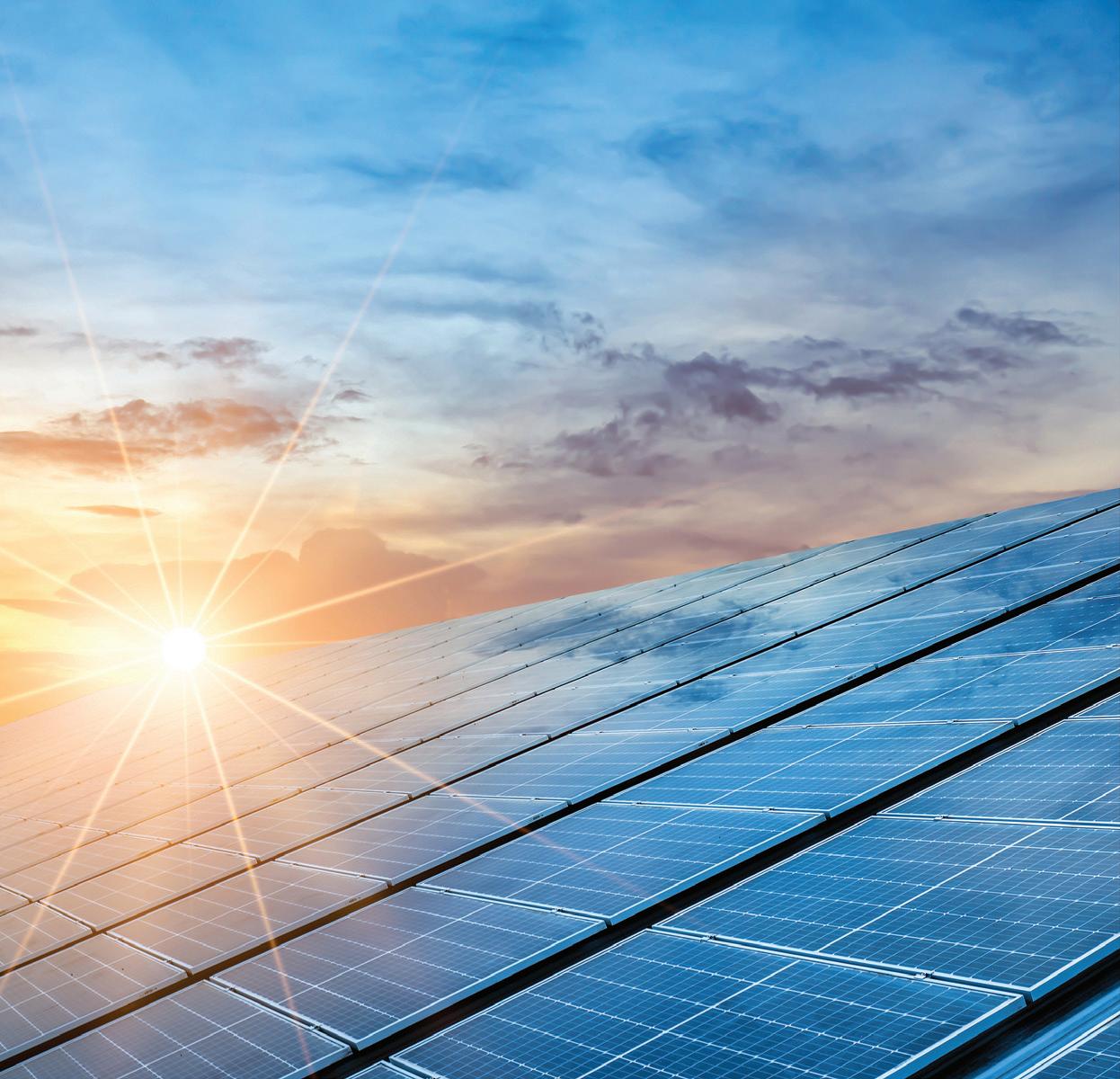
AND THEY’RE OFF: THE STATE RACE TO NETWORK REGIONS OF RENEWABLES
by Chris Allan, Journalist, Energy magazine
In 2020, the Australian Energy Market Operator (AEMO) released its 20-year vision for the National Electricity Market (NEM). A winning move in their strategy for renewables is the state-led networking of Renewable Energy Zones (REZs) – regional hotspots rich with renewable potential. Here we take a look at how these special districts of renewables could completely transform both state energy infrastructure and the NEM.
Building an Australian energy market that is more secure, reliable and affordable will require nothing if not wellinformed decision-making. Over the next 20 years, Australia’s states will transform existing network transmission to meet challenges like emission reduction targets, the growth of load centres, as well as the fair integration of new and decentralised means of energy generation.
But despite mounting pressures to future-proof the NEM, it’s worth remembering that the smartest network upgrades can begin with simply ‘working backwards’: by closely assessing existing infrastructure and natural resource potential, policymakers and authorities can fine-tune the best strategies for state upgrades.
September 2021 ISSUE 15 www.energymagazine.com.au
14 FUTURE ENERGY
Enter the Renewable Energy Zones
REZs are geographic hotspots of potential – state-based regions that are best suited for large-scale renewable projects.
At present, the state governments of Queensland, Victoria and New South Wales alone have committed to 14 Renewable Energy Zones, each zone featuring technologies like wind, solar, pumped hydro and battery storage.
The REZ report card
In 2020, the Australian Energy Market Operator (AEMO) delivered a detailed report card of candidate REZs across the states as part of its Integrated System Plan (ISP), a twenty-year blueprint for the national electricity market.
AEMO’s REZ report card, a standardised assessment of renewable energy hotspots, graded REZs on key performance indicators like average capacity, correlation of output with regional demand, and best storage option.
Why REZs make sense
A standardised upgrade of Australia’s renewable energy hotspots would bring renewable hubs onto the same playing field as the highly-dispatchable energy sources of our recent past, such as coal-fired generation.
REZs empower state experts to find optimal solutions for current challenges like ‘at-capacity’ transmission infrastructure, emission reduction targets, and the fair management of decentralised and diverse energy sources.
And emerging research continues to show that Australia’s renewable energy policy stands to benefit from regional solutions and technologies.
In July, the Blue Economy Cooperative Research Centre (BECRC) published a report that found that over 2,000GW of offshore wind power could be installed across Australia, all within 100km of existing substations and led by critical hotspots such as Newcastle, Gippsland, and Gladstone.
Renewable Energy Zones: state by state
Victoria
Victoria has already committed to six Renewable Energy Zones across the state. The $540 million of REZ funding comes as part of a $1.6 billion clean energy package in the 2020-2021 State Budget.
While the Gippsland REZ has good existing network capacity via historical coal-fired power infrastructure, upgrades to address network capacity issues in other Victorian REZs would relieve the output restrictions and loss factors that currently face generators.
The Australian Renewable Energy Agency (ARENA) has already advised that existing thermal and system strength issues should be addressed to avoid further curtailment of current and future energy projects in two north-western REZs (Murray River, Western Victoria). The six Victorian REZs are:
1. Gippsland (includes Hazlewood, Loy Yang regions)
With Victoria’s highest rating of existing network capacity (2,000MW), AEMO predicts significant renewable energy generation in the Gippsland REZ with “the retirements of coal-fired generation”. The Gippsland REZ stands to benefit from both a robust existing network in the region as well as excellent potential for on- and off-shore wind power.
2. Central North (Shepparton, Glenrowan)
The Central North REZ hosts existing solar projects, with modest potential for future solar and wind projects. However, an upgrade in transfer capability with NSW would unlock greater host capability (MW) for new projects.
3. Murray River (Bendigo, Kerang, Wemen, Red Cliffs)
Despite its remoteness, large-scale solar in this REZ could boost interstate connections, should transfer capability with NSW be upgraded. At present, generators face restricted output due to network capacity issues (voltage stability, thermal limits).
4. Ovens Murray (Eildon, Dederang)
According to AEMO, Ovens Murray was selected as a REZ candidate for both its existing pumped-hydro generation as well as proximity to the Melbourne load centre, making it an ideal candidate for Step Change energy storage.
5. South West Victoria (Portland, Heywood, Terang, Mortlake)
With moderate to good quality wind resources and large existing wind farms, the South West Victoria REZ has a 750MW hosting capacity via the 500kV network from Heywood to Moorabool.
6. Western Victoria (Ballarat, North Ballarat, Waubra, Bulgana, Horsham) While wind resources in the Western Victoria REZ are graded by AEMO as good to excellent, the current network is constrained and desperately needs transmission upgrades, with both interstate and regional augmentations on the cards.
Queensland
In Queensland, the State Treasury has allocated $145 million to launch three Queensland Renewable Energy Zones (QREZs) – corridor-like projects that span many of the original candidate hotspots proposed by AEMO. In September 2020, 192 projects registered their interest to be part of Queensland’s renewables pipeline.
The three QREZs are:
1. The Northern QREZ (includes Cairns, Townsville and Mackay)
The Northern QREZ offers excellent wind resources, and the Queensland Government has already secured $40 million in transmission upgrades between Cairns and Townsville that could unlock 500MW of new energy production.
The lead project under construction in the Northern QREZ is a 157MW wind farm at the Kaban Green Power Hub, scheduled to be operational by 2023. Further wind projects in the region could importantly “balance out” the uptime of energy production further south in the national electricity market.
Queensland Premier, Annastacia Palaszczuk, assured that alongside the Kidston Pumped Hydro Storage Project, the Kaban wind farm will “power the North and keep Queensland on track to meet our 50 per cent renewables target by 2030”.
2. The Central QREZ (Gladstone, Bundaberg)
The Australia New Zealand Infrastructure Pipeline (ANZIP) has identified Fitzroy and Wide Bay as probable locations for new renewable projects in the Central QREZ, which accepted registrations of interest (ROI) in September 2020.
The AEMO REZ report card found that the Fitzroy REZ has good solar and wind resources despite no existing renewable projects, while Wide Bay already features modest solar farms.
Although AEMO concluded that “significant transmission build” is needed to allow new projects in the Gladstone region to service the state’s southern load centres, storage options such as pumped hydro and batteries could be invaluable for buffering any future generation in the region.
3. The Southern QREZ (Toowoomba, Brisbane)
The Southern QREZ accepted registrations of interest (ROI) in September 2020, with the Darling Downs region being a key site for future project announcements. AEMO’s report card on the Darling Downs region found that it offers not only good solar and wind resources, but also “a strong network with good potential to connect renewable generation”.
As the only Queensland candidate REZ with access to the transmission network at 330kV, the Darling Downs region could lead support of the nearby load centre of Brisbane via a combination of wind projects and solar projects, with select storage options.
www.energymagazine.com.au September 2021 ISSUE 15 15 FUTURE ENERGY
New South Wales
In its 2020 Electricity Infrastructure Roadmap, the New South Wales Government committed to building five Renewable Energy Zones, delivering an intended network capacity of 12GW. The leading project of NSW’s rollout is the Central West Orana REZ, which has already garnered $40 million in state funding by June 2020.
The five NSW REZs are:
1. Central-West Orana (Dubbo)
The first REZ to be developed in NSW will be the CentralWest Orana pilot REZ, which is set to unlock 3,000MW of generation by the mid-2020s – enough to power 1.4 million homes. Concurrent upgrades of Central-West Orana transmission infrastructure will allow new generators to export electricity to the rest of the network. AEMO’s report card of the Central-West Orana REZ notes its invaluable proximity to the Sydney load centre. AEMO graded its solar and wind resources as high and moderate respectively, also noting opportunities for pumped hydro and battery storage.
2. New England (Armidale)
The NSW Government has locked in $78.9 million to develop the New England REZ, intended to deliver up to 8,000MW of transmission capacity. Registration of interest for generation, storage and network projects for the New England REZ closed in late July.
AEMO’s report card entry for New England noted its moderate to good solar and wind resources, its proximity to the Queensland border as well as opportunities for largescale storage via batteries and pumped hydro.
3. South-Wes t (Hay)
Early planning for the South-West REZ suggests it will be located around the town of Hay. Of note, this REZ is proximate to EnergyConnect, a proposed interconnector that could importantly link the NSW and SA markets.
While AEMO found that there are good solar resources in this area, extensive transmission upgrades are required for new generation to reach the load centre of Sydney.
4. Hunter-Central Coast
The NSW government selected the Hunter-Central Coast region as a future REZ despite it not being a candidate ever suggested in AEMO’s 2020 Integrated System Plan. In 2020, NSW Energy and Environment Minister, Matt Kean, explained that, “The Hunter has been at the heart and soul of our energy industry for generations”. Mr Kean further noted that new generation could make use of the existing transmission infrastructure set up by previous generators, such as the soon to be closed Liddell Power Plant.
5. Illawarra
The NSW Government’s selection of Illawarra as a planned REZ is recognition of its growing hydrogen industry. Indeed, Labor Member for Wollongong, Paul Scully, and NSW Greens Energy Spokesperson, David Shoebridge, have both raised the valuable application of hydrogen in essential industrial processes such as steel making.
South Australia
While AEMO did release its analysis of South Australian candidate REZs, there has been minimal announcements on the project from state government authorities.
According to AEMO, South Australia has already been a net exporter of energy to Victoria for the last two years, driven by the state’s early uptake of large-scale renewable projects as well as the recent decline of coal-fired generation in Victoria.
In a 2018 discussion paper on AEMO’s ISP, South Australian Minister for Energy and Mining, Dan van Holst Pellekaan, stressed his commitment to address ongoing congestion issues faced by existing renewable generators of his state.
Mr van Holst Pellekaan called for further involvement of generators in network decision-making, arguing that involving generators in conversations around transmission upgrades will “reduce the risk of overinvestment in transmission networks”.
While state response to the REZ program has been muted, South Australia is still well on its way to reaching net 100 per cent renewable power by 2030.
Projects like EnergyConnect, a proposed $1.5 billion interconnector project with New South Wales, speak to South Australia’s ongoing commitment to bolster its transmission network for the future.
Tasmania
While AEMO has identified three candidate Renewable Energy Zones in Tasmania, namely the North West, North East and Midlands REZs, state government authorities are currently in a period of community consultation, and have emphasised that development of Tasmanian REZs “will be complex and take many years”.
All three of Tasmania’s candidate REZs have good to excellent grade wind resources, with the Midlands REZ also offering good pumped hydro potential.
Although Tasmania has been a net exporter of electricity since 2017, and hasn’t yet announced any REZ funding to boost its existing renewables, the state could become even more influential in the future – Tasmanian wind farms have the potential to support the national electricity market during the down time of mainland generators.
The gold standard
Over the next 20 years, AEMO prescribes a 200 per cent increase in distributed energy resources (DER), such as rooftop solar, to cover at least 13-22 per cent of total consumption.
According to AEMO, the gold standard in energy generation of the future is a ‘highly diverse portfolio’ of energy sources, that takes us away from a centralised coal-fired generation system. Achieving this diverse portfolio will require large-scale renewable projects and technologies, not to mention dramatic upgrade of transmission infrastructure.
THE REZ LIFE CYCLE
According to AEMO, each REZ project progresses through five stages of development, from initial concept through to final construction:
1. Concept (Identify and refine candidate REZ sites)
2. Architecture (Functional network design, identify actionable projects)
3. Configuration (Community engagement, land-use assessment, improved costing)
4. Detailed Design (Detailed engineering design, finalisation of funding)
5. Construction and Commissioning (Agreements executed, financial close)
September 2021 ISSUE 15 www.energymagazine.com.au
16 FUTURE ENERGY
South-West
Northern QREZ
Townsville
Murray River
Western Victoria
Central North
Shepparton
Bendigo
South West
Ballarat
Mortlake
Central-West Orana
Dubbo
Dederang
Ovens Murray
Loy Yang
Gippsland
REZs are starting to take shape across the country, especially in Queensland, Victoria, and New South Wales.
Central QREZ
Gladstone
Brisbane
New England
Armidale
Hunter-Central Coast
Southern QREZ
Newcastle
Illawarra
Wollongong
www.energymagazine.com.au September 2021 ISSUE 15 17 FUTURE ENERGY
BIOENERGY INVESTMENT TO SUPPORT AUSTRALIA’S PATH TO NET ZERO
Leading Australian resource recovery company ResourceCo says an increasing focus on Australia’s carbon footprint, future net zero commitments from larger corporations, and bolder government policy is driving strong confidence in the sector.
The Clean Energy Finance Corporation (CEFC) recently identified an investment pipeline of up to $7.8 billion across Australia’s waste, bioenergy, recycling, and resource recovery sectors.
New and expanded infrastructure requirements for the sector are expected to deliver 9,000 construction jobs, 2,600 indirect jobs, and as many as 1,400 direct or ongoing jobs.
CEO of ResourceCo, Jim Fairweather, says global market pressures, evolving consumer preferences and an increasing focus on the country’s carbon footprint, both at an individual company and nationwide level, are driving significant transformation.
“It’s an exciting time to be involved and it’s important that we all work together to capture the opportunities for expansion across the Australian sector, driving strong economic and environmental outcomes,” Mr Fairweather says.
As an experienced investor in the bioenergy and thermal energy from waste sectors, the CEFC sees immediate and important investment opportunities in recycling and resource recovery, drawing on proven technologies and products.
Amongst those is Processed Engineered Fuel (PEF), which has the potential to address constrained and increasingly expensive landfill, and growing demand from industrial facilities, both in Australia and overseas, for lower carbon waste-derived fuels.
Head of ResourceCo Energy Systems, Henry Anning, agrees the scope for PEF is increasing as the global market continues to explore options for accelerating emissions reduction, while achieving cost-efficiencies.
“Increasingly, large-scale businesses are looking to renewable energy as a viable alternative to expensive, emissions generating fossil fuels. We’re continuing to progress some interesting and ambitious new projects across our national footprint which bears testament to the evolving opportunity,” Mr Anning says.
As a company, ResourceCo is a leader in the development of energy from waste plants, which deliver strong environmental and economic outcomes by repurposing materials otherwise destined for landfill, to generate clean energy.
ResourceCo Energy manufactures PEF primarily from waste timber materials but also non-recyclable plastics, cardboard, paper, and textiles.
“We’re solidifying our commitment to make progress for real change and to play our part in progressing Australia’s transition to a circular economy,” Mr Anning says.
ResourceCo’s optimism is also shared by its tyre recycling division, Tyrecycle, which is undertaking an expansive capital investment program – the biggest in the history of the company – with new plants planned for Sydney and Perth, as well as bolstering operations in South Australia, Victoria, and Queensland.
“We’re expanding our production capacity and capability for tyre-derivedfuel (TDF) and rubber crumb (used in road construction), ahead of the December 2021 ban on the export of whole-baled tyres,” Mr Fairweather says.
“We’re focused on progressing growth opportunities to improve access to export markets and supply chains, while also expanding local markets for recycled tyre-derived fuel products.

“We’ve got an important role to play in embracing innovation to expand the sector into a sustainable global contributor to a circular economy. The upside is huge.”
18 FUTURE ENERGY SPONSORED EDITORIAL

TOMORROW’S SOLUTIONS. TODAY
VICTORIA'S GAS INFRASTRUCTURE: WHAT DOES THE FUTURE HOLD?
by April Shepherd, Journalist, Energy magazine
As Victoria continues to pursue its goal of net zero emissions by 2050, Infrastructure Victoria has invited the community to respond to the latest interim report, outlining the possible future for Victoria's gas infrastructure, and how the state needs to change its relationship with natural gas.

Infrastructure Victoria has been asked to advise the Victorian Government on the state's gas transmission and distribution networks, offering a range of 2050 energy sector scenarios. For a state that has relied heavily on gas for over half a century, transitioning to zero emissions is going to require a whole-of-economy response and dedication to the vision.
Infrastructure Victoria’s new interim report, Towards 2050: Gas infrastructure in a zero emissions economy, discusses the role of gas infrastructure in a zero emissions economy, presenting evidence and analysis that will underpin Infrastructure Victoria’s final advice.
Community feedback on the evidence and analysis presented in the report may influence Infrastructure Victoria’s final response to the government, which will be presented in a report released in December 2021.
The advice will assess the relative economic, social, and environmental impacts of each scenario and identify infrastructure decisions that need to be made, ensuring opportunities for existing gas infrastructure use is optimised.
Evidence from the report so far shows that significant change is required to meet interim emissions reduction targets and reach net zero by 2050, developing four distinct illustrative scenarios.
Four gas scenarios
In developing the report’s evidence base, Infrastructure Victoria considered four illustrative scenarios to achieve net zero emissions for gas use in Victoria by 2050.
The scenarios test key variables regarding the potential technology mix (electrification, natural gas, hydrogen and biogas) and the mechanism by which net zero emissions can be achieved – whether emissions are eliminated or managed by solutions such as carbon offsets and carbon capture and storage (CCS).
The four scenarios are:
» Scenario A: full electrification, no natural gas (by 2050), no CCS
» Scenario B: partial electrification, limited natural gas use (in 2050), limited CCS
» Scenario C: green and blue hydrogen with carbon offsets, electrification, no natural gas (by 2050), no CCS
» Scenario D: large-scale brown hydrogen, large-scale CCS, no natural gas (by 2050)
Early findings from the interim report show:
» A mix of approaches will be needed to transform how Victorians use gas, to reduce emissions, manage risks, minimise costs and create new opportunities for jobs and industry.
» The Victorian Government can support greater use of proven, low carbon solutions including energy efficiency, electrification and biogas to achieve emissions reduction.
» There may be a role for gas-fired electricity generation to support our increasing use of renewable energy during the transition to net zero.
» The Government can continue to support further development and demonstration of emerging technologies, including low emissions hydrogen, biomethane and carbon capture and storage until their viability at scale is known.
» Reducing Victoria’s overall gas demand, especially in the household and commercial sectors where it is mostly used for heating, can reserve supplies for critical industrial purposes such as chemical manufacturing.
» Future infrastructure and network investment decisions can be tested for compatibility with pathways to net zero. For example, expanding existing gas networks to new residential and commercial developments may embed future emissions and could mean a larger potentially underused or stranded asset.
Gas to become history
Victoria's relationship with gas began in the late-1960s, with pipeline gas powering much of Victoria ever since.
A large gas network extends across the state, with storage facilities to help meet demand peaks and significant interconnections with other states.
The Victorian gas network includes 1,900km of gas transmission pipelines, 32,000km of gas distribution pipelines and assets valued at nearly $6 billion.
Victoria’s gas usage accounts for one fifth of the state’s emissions, so when the state committed to a whole-of-economy, net zero emissions target by 2050, under Victorian Climate Change Act 2017, gas was an obvious obstacle to conquer.
Infrastructure Victoria CEO, Michel Masson, said, “Natural gas has been good to Victoria for more than half a century, heating
September 2021 ISSUE 15 www.energymagazine.com.au
20 FUTURE ENERGY

our homes, cooking our food, and powering our industries and businesses all thanks to cheap, local supply.
“But the days of cheap gas are coming to an end.
“Natural gas is also a fossil fuel responsible for 20 per cent of the state’s greenhouse gas emissions, meaning our use of gas must change significantly if Victoria is to meet its emissions reductions targets and reduce the risks of climate change.”
What does the future hold?
Mr Masson said the road to net zero, regardless of how it happens, is a critical opportunity for the state that will affect most Victorian households, businesses and industries.
Towards 2050: Gas infrastructure in a zero emissions economy, states that, “The Victorian Climate Change Act 2017 establishes a system of coordinated, whole-of-economy actions to achieve a net zero emissions target by 2050, including rolling five-year plans and targets to reduce emissions".
Meeting the state’s emissions targets will be challenging. The Victorian Government has a crucial role to play in enabling
the transformation by providing clear market signals, creating incentives to reduce, replace or decarbonise gas, and aligning its own policies and regulations with interim and 30-year emissions reduction targets.
The report supports these sentiments, with the journey to cutting emissions slowly slipping to a matter of urgency, as the report states, “Victoria’s energy system must transform to reduce greenhouse gas emissions and limit the impacts of climate change”.
“Reducing greenhouse gas emissions at the scale required to meet net zero emissions needs an economy-wide response, including the gas sector.”

21 FUTURE ENERGY
Victorians have long used gas for residential heating; but according to Infrastructure Victoria, this will need to change if the state is to achieve net zero emissions by 2050.
IT’S DARK, IT’S STILL – IT’S DUNKELFLAUTE

 by Chris Gilbert, Energy Networks Australia, Senior Economic Advisor
by Chris Gilbert, Energy Networks Australia, Senior Economic Advisor
Dunkelflaute (dunk-el-flout-eh) is a German word meaning ‘dark lull’ and is a phenomenon energy professionals need to know about and energy systems need to manage. It describes extended events with minimal wind or sunshine in highly-renewable electricity systems – and as Australia’s energy system transforms, it’s something we need to be aware of, plan for and overcome.
Whether you’ve heard of it or not, the challenge dunkelflaute presents is obvious – how to guarantee electricity supply when the dark lull descends?
In Australia, this has been referred to as a renewable drought. A recent lull in wind generation in South Australia is a smallscale snapshot of what could become a much larger problem in the future.
AEMO data (via Open NEM) shows that from 11-12 June, wind power (represented by green in Figure 1) generated fewer than 4,800MWh of a total demanded 55,000MWh, only 8.7 per cent of total generation. This is compared with 9-10 June when wind power generated 46,000MWh out of a total demanded 73,000MWh, contributing 63 per cent to generation.
Germany is in a similar position as South Australia in terms of renewable penetration. Renewable electricity in Germany contributed 45.4 per cent of electricity consumption in 2020, more than coal, oil and gas combined. Germany also has a significant transmission connection with the

EU, possessing more interconnectors than any other country in Europe.
In Germany there is a growing fear of dunkelflaute, as the share of renewable generation increases and displaces dispatchable generation. The type of event to cause dunkelflaute doesn’t have to be severe weather like we saw in Texas in February, it can be as benign as several still winter days in a row.
How do we manage dunkelflaute?
A recent Grattan Institute report, Go for net zero, referenced dunkelflaute as ‘the winter problem’. In the document, Grattan
notes that an energy system with 90 per cent renewable electricity would reduce emissions by 105 million tonnes at a cost of less than $20 per tonne. The final 10 per cent, however, is much trickier to achieve because the electricity system must increasingly rely on firming options.
The immediately available electricity storage option that might come to mind is batteries – but batteries tend to be best suited to managing hourly fluctuations across the day, charging from the midday sun and then discharging to help with the evening peak.
September 2021 ISSUE 15 www.energymagazine.com.au
22 FUTURE ENERGY
Figure 1. SA generation by resource type, 9th to 12th June 2021. Source: Open NEM.
Today’s batteries are not well placed to manage longer durations, with most having less than four hours of storage. The Victorian 300MW Big Battery project in Geelong is slated to be able to provide electricity to 400,000 households for one hour at full charge. That may be big, but managing dunkelflaute will require a much bigger battery.
Broadly, there appear to be three options that could assist the transition from 90 to 100 per cent renewables.
Lots of renewable generation and transmission
The first is building a diverse renewable generation fleet all across the country in hopes that the wind is blowing or sun is shining somewhere, while ensuring sufficient interconnection to transport large quantities of electricity all across the country. This option would result in a large amount of electricity being ‘wasted’, along with lowering the utilisation of interconnection, while still leaving room for dunkelflaute in severe cases.
There is a positive correlation between solar energy across the National Energy Market (NEM) shown in Figure 2. When the sun is shining in one area, it is also likely to be shining in others, and vice versa. The absence of solar energy in one region may not be easily replaced by solar in another as different regions can be affected by similar weather systems.
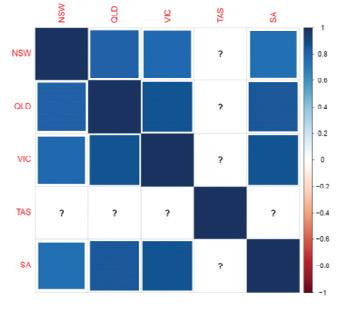

Deep storage
The second option is building deep storage, like pumped hydro, that by its nature is well placed to provide storage capacity. Snowy 2.0 for example will be able to provide 2,000MW of generation capacity for 175 hours at full capacity. Grattan has modelled that across a ten-year period, up to 9GW of storage capacity might be required to bridge the largest gap between renewable generation and demand over 14 days. That’s about nine Snowy 2.0’s, assuming they all start at full capacity.
This type of deep storage solution is likely to sit idle most of the time and could be challenging to finance, with Grattan rightly noting that many optimal sites for pumped hydro have already been developed. Additional interconnection would also be required to connect this deep storage, which may again be poorly utilised.
Developing this much deep storage is likely to be incredibly costly and unlikely to be in the customer's best interests.
Zero emissions dispatchable energy
The third and most promising option is building zero-emissions dispatchable energy, consisting of renewable gas usage in gas powered generation plants. Natural gas already provides a similar role in today’s generation mix, and renewable gas will allow much of the current infrastructure to be utilised to support high levels of variable renewable electricity generation.
Frontier Economics examined the role of gas powered generation in South Australia during renewable droughts to support a
highly-renewable system and found that using gas powered generation could reduce the overall system cost by between 28 to 35 per cent per year, depending on the extent of the renewable drought during winter.
The optimal level of gas generation was found to be 7 per cent of total generation. If natural gas can be substituted by renewable gas into the future, it’s likely that full decarbonisation can be achieved by utilising existing infrastructure and lowering overall costs.
Managing the winter lull

Dunkelflaute is a challenging problem that requires detailed planning and mapping of the electricity system and usage throughout the year, rather than relying on averages that are more commonly talked about.
There are a range of technical options available to manage dunkelflaute. Batteries and pumped hydro can be good options for managing hourly and daily fluctuations in demand, but there are questions over longer durations. Shorter-term storage is likely to best be complemented by renewable gas electricity generation to manage longer periods of low variable renewable generation.
www.energymagazine.com.au September 2021 ISSUE 15 23 FUTURE ENERGY
Figure 2. Correlation of solar generation in the NEM. Source: Frontier Economics Bulletin – Sunny With a Chance of Wind.
Figure 3. Indexed systems cost for 2030 and 2035 – South Australia. Source: Frontier Economics (2021), Potential for gas-powered generation to support renewables.
NATIONAL MODELLING ELECTRICITY SECTOR PLAN

A federal climate research team – the Electricity Sector Climate Information (ESCI) project – this year achieved their $6.1 million goal of delivering high-quality climate data for the electricity sector to use. The publicly available resources of the ESCI project include high-resolution climate models, in-depth case studies, and a full risk assessment workflow – so it’s no surprise that industry leaders are already leveraging these new tools for electricity sector planning and risk modelling.
The ESCI project
Australia’s federal government is focused on delivering a more secure, reliable, and affordable energy market – but what does that look like in the context of future climate risk?
The Electricity Sector Climate Information (ESCI), a government project that provides climate modelling data for the national electricity market (NEM), has spent the last three years answering this question.
Born from recommendations of the 2017 Finkel review into the Future Security of the National Electricity Market (NEM), the ESCI project ran from 2019 to 2021, and brought together climate scientists with key actors in the electricity sector. Collaborators included the CSIRO, the Bureau of Meteorology (BoM), and the Australian Energy Market Operator (AEMO).
Key deliverables of the $6.1 million ESCI project include high-resolution climate modelling data, a comprehensive climate risk assessment workflow, and case studies of interactions between climate risks and the electricity market.
Some of the project’s intended outcomes for electricity market players include improving the safety of assets, maximising profitability, and pre-empting future shifts in consumer demand.
What’s on offer?
High-resolution climate modelling
A leading achievement of the ESCI project is the production of high-resolution climate projections that stretch as far as the year 2100, captured at sub-daily intervals.
The ESCI project’s national climate datasets simulate future change in climatic variables like minimum and maximum temperature, rainfall, wind speed, and forest fire danger index (FFDI).
According to a spokesperson for the Department of Industry, Science, Energy and Resources, climate modelling datasets have been specifically developed to address the interests of the energy industry.
“This data is available across all of Australia, however particular focus has been placed on 168 locations which are of interest to the electricity sector, including major demand centres and transmission lines, renewable energy zones and large conventional generators.”
The ESCI climate datasets, available in multiple formats including maps and time series plots, will empower industry stakeholders to consider how weather and climate variables can affect future infrastructure security, energy generation and demand patterns.
The climate risk assessment workflow
The three-year ESCI project has also delivered a comprehensive Climate Risk Assessment Framework, a five-step method for the electricity sector to integrate climate change risk into future decision-making.
Designed and tested by electricity sector stakeholders as well as climate experts, the ESCI’s Climate Risk Assessment Framework draws on existing documentation such as:
» International Standard ISO 31000: Risk Management
» International Standard ISO 14090: Adaptation to Climate Change
Each of the five steps in the ESCI’s comprehensive climate risk assessment is described and demonstrated by online user guidance resources.
24 FUTURE ENERGY
MODELLING DATA TO HELP AROUND CLIMATE RISK

Why consider climate risk in the industry?
The ESCI project statement points to existing evidence that the climate is fundamentally changing:
“Climate impacts on the electricity system have been felt through extreme weather events such as heatwaves, floods, wind-storms, drought and fires.”
A climate risk assessment considers the data of climate modelling, then answers the important question of how these trends could affect real-world vulnerabilities of our electricity market infrastructure.
Indeed, potential applications of climate risk assessment for the electricity sector include:
» Prioritising climate risks that require mitigation
» Managing asset safety, reliability, and potential for destruction
» Designing new asset specifications for future operating conditions
» Calculating market benefits attributable to regulate investments
» Looking at potential changes in cash flow and profitability
» Considering changes to operating conditions of the integrated power system
Case studies: climate and industry interactions
The ESCI project also delivered key case studies of interactions between climatic variables and industry infrastructure and priorities.
These case studies – covering topics such as the risk of bushfire along transmission routes – help show the applications of the ESCI project’s outputs, such as climate modelling and climate risk management – to solve real-world issues.
Case study: transmission in severe wind contexts
One of the ESCI project’s case studies considers how severe winds can cause transmission lines to fail, affecting the reliability of electricity supply to customers.
According to a Department of Industry, Science, Energy and Resource spokesperson, the ESCI project’s latest modelling of sever convective wind shows that “a number of existing transmission lines are built in areas that are vulnerable to high winds”.
“This does not necessarily mean these lines are built in the ‘wrong place’, because these risks need to be considered in conjunction with other business risks.”
The Department spokesperson pointed to risk reduction options such as transmission route planning, asset maintenance, engineering requirements and system redundancy options, to reduce the likelihood and impact of transmission line failures.
New horizons for ESCI data
The success of the ESCI project’s outcomes is already evident in uptake of project data by key industry actors such as the Australian Energy Market Operator (AEMO), and the Australian Climate Service (ACS).
A Department of Industry, Science, Energy and Resources spokesperson noted that AEMO has already used preliminary ESCI data in the influential 2020 Integrated System Plan (ISP), further stating that “the final suite of ESCI data gives AEMO an unprecedented collection of cutting-edge climate information to use in the 2022 ISP".
The ACS, a new Commonwealth body that launched its operations in July, will also draw on ESCI datasets among other resources to support Australia’s preparation for and response to climate events and natural hazards.
25 FUTURE ENERGY
GEARING UP FOR THE ENERGY STORAGE ERA
by Michael Bradley, Executive General Manager, Retail and Wholesale Markets and Victoria Mollard, Executive General Manager, Security and Reliability, AEMC
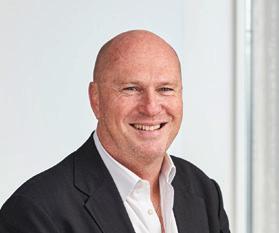

Whether they sit in our smartphone, garage remote control or laptop, batteries are integrated into our everyday lives.
As battery technology is increasingly used in consumer gadgets and electric cars, it has also gotten cheaper.
The costs of lithium ion batteries fell sharply by 89 per cent between 2010 and 2020 -- a trend that is set to continue, according to Bloomberg New Energy Finance research.
Battery technology is becoming more economic and more ubiquitous.
And batteries, along with other energy storage technologies, will play a more critical role in Australia’s future power system too.
The Australian Energy Market Operator’s 2020 Integrated System Plan forecasts an influx in storage across the grid: capacity is expected to be about eight times higher within the next two decades.
Meanwhile, state and territory governments across the southeastern and eastern states that make up the national electricity market (NEM) have rolled out policies to incentivise storage.
More households with solar batteries are expected.
So too are more grid-scale storage systems and the emergence of innovative new business models that combine different technologies behind a connection point to both consume and export electricity.
As batteries continue to play an increasingly important role in Australia’s evolving energy system, the Australian Energy Market Commission is laying the foundations for the best ways to integrate batteries – and distributed energy sources – into our grid.
To be sure, storage systems are not new in the Australian electricity grid. Part of the iconic Snowy Hydro scheme, Tumut 3, was built in 1973 as a pumped-hydro unit that can store energy.
Since the 2017 connection of the Hornsdale Power Reserve in South Australia, four further grid-scale batteries have been hooked up to the NEM. Others are planned.
Underscoring the potential for hybrid facilities, North Queensland’s Kennedy Energy Park – the nation’s first project to combine solar, wind and battery storage behind a connection point – has recently started sending electricity to the NEM.
Given the forecast influx of energy storage, the time is right to look at how changes to the national energy rules can accommodate the exciting new storage era that is upon us.
The Australian Energy Market Commission has been working on a slew of complementary projects that will get the market ready for a future where batteries have a pivotal role to play – to back up the cost benefits of a burgeoning fleet of weather-reliant renewables, soak up excess solar power from rooftop PV, and provide important system services as aging coal-fired generators retire.
These projects include our draft plan to integrate storage into the NEM, our final decision to create a fast frequency response service that rewards providers like batteries for providing ultra-quick frequency control, and our work to smooth how we embed distributed energy into the system so that all energy consumers benefit.

26 FUTURE ENERGY
All are aimed at providing stronger incentives for storage while also safeguarding the security of the electricity system.
All dovetail with the Energy Security Board’s (ESB) work in developing a fit-for-purpose future market.
While some of our work solves pressing immediate issues, it also takes important foundational steps towards the two-sided market being developed through the ESB’s post 2025 project.
Our draft decision on integrating energy storage, which we’ve released in response to a rule change request from the Australian Energy Market Operator (AEMO), makes it easier for grid-scale storage to participate in the NEM.
Our plan would allow the owners of both small household and grid-scale batteries to achieve greater value from their investment.
The draft rule creates a new category of market participant that accommodates a variety of different participants who can both offer and consume energy, and the important ancillary services that maintain security in the NEM.
The new category is technology-neutral and so includes grid-scale storage, pumped hydro, hybrids and aggregators of small-scale generation and storage units.
Importantly, by creating the one category we can also be ready for tomorrow’s technologies, helping spur innovation in them. Take hybrids. These weren’t in operation when the National Electricity Rules were first designed. But by allowing wind and solar projects scope to provide their own solutions to weather intermittency by co-locating with a battery, our proposal could help enable renewables.
Another example, aggregators, would be able to provide both energy and market ancillary services to the grid.
While some retailers are already doing this with customers through virtual power plant trials, we expect both aggregators and retailers would be able to do so if registered under the new participant category. This level playing field paves the way for innovative new businesses who would be better able to use batteries to their full potential and gives customers a greater choice of services.
Households with solar panels and batteries could earn extra income by signing up with these aggregator businesses who could access multiple markets on behalf of consumers that they weren’t able to before.
This is in line with our proposals on integrating small-scale solar and other distributed energy resources into the grid, by
having market signals that reward customers for exporting or not exporting power to grid at different times in accordance with system needs.
These projects work together to provide the incentives that will lead to batteries becoming an important feature of the future energy market and an enabler of the transition to a lower emissions power system.
For large batteries, our draft plan would streamline the way batteries register and participate in the NEM. It does this by removing the need for batteries to register under two different categories, which has been costly and complicated, and by allowing them to compete evenly with other market participants.
Also, as AEMO had raised concerns about a lack of clarity on how network charges apply to grid-scale storage and hybrids, we are proposing minor amendments to clarify how these network charges apply. Our draft doesn’t exempt any specific technology, including batteries, from charges associated with using the network. Instead, it makes it clearer that the network tariffs should better reflect the cost of how and when the network is used. We are taking submissions on these proposals until September 16 and welcome all views.
As well, under our final decision that creates a fast frequency response market, large batteries will be able to earn revenues by supplying two brand new markets: a “raise” service to correct falling frequency, and a “lower” service for rising frequency – each within two seconds.
While there are existing Frequency Control Ancillary Services (FCAS) markets – the fastest response time is currently six seconds. These new markets open the door to ultra-fast options not currently available in the energy sector.
The new markets allow any technology to participate that can provide this service to keep the system secure in real-time. Batteries are likely to be large participants because they are extremely well-placed to inject power to the grid in two seconds or less.
The type of large-scale disruption and change now occurring in the energy sector is throwing up plenty of challenges. But the opportunities to think about and do things differently are immense and exciting. We’re pleased to have advanced this important work that will pave the way for batteries and other storage solutions in the NEM. It’s a stride along the path to a very different future.

27 FUTURE ENERGY
ZENAJI AEON BATTERY PASSES ALL AUSTRALIAN TESTS


After months of testing, the Australian designed and assembled Zenaji Aeon battery was approved by the Clean Energy Council for the Australian market. These Lithium Titanate (LTO) batteries are a leap forward in power storage technology for both domestic and commercial settings, and can now be used by Australian customers with greater confidence.
Renowned laboratory certification company
TUV Rhineland has certified the Zenaji Aeon battery and its associated Battery Management System (BMS) to meet both IEC 62619:2017 and IEC 62040-1:2017 Standards. The Zenaji Aeon battery is also certified by independent labs to meet IP65 and EMC (Electrical Emissions) Standards.
In recent times, recalls of brand name batteries due to their role in starting fires have raised concerns about safety. The Zenaji Aeon’s certifications and commitment to safety standards provide consumers with peace of mind. Unlike other lithium battery chemistries, the Zenaji Aeon’s LTO cells do not result in thermal runaway, which is a spontaneous combustion process caused by dendritic growth in the battery. Dendritic growth can lead to a fire at any time regardless of whether the battery is charged or discharged.
With a warranted cycle life of 20 years (or 22,000 cycles) and a tough, weatherproof aluminium case, the Zenaji Aeon battery is a lifetime solution for energy storage needs. Each Zenaji Aeon battery provides 1.93kWh of energy storage and, with their superior cycling performance, allows three cycles a day to take complete advantage of your energy production and off-peak energy pricing plan.
The batteries allow for a system to capture and store solar power throughout the day to be used at night rather than feeding this power back into the grid and further reduces the property’s energy bill. When the grid is down, the stored energy from Zenaji Aeon batteries, with the appropriate inverter and utility approval, can automatically switch to off-grid mode and continue to supply power.
The Zenaji Aeon battery is designed to provide long lasting, reliable power for domestic applications through to large-scale storage requirements in industrial and commercial applications. Zenaji also offers the Eternity battery which was developed to meet the growing demand for commercial scale energy storage.
Taking full advantage of the incredible charge and discharge characteristics of LTO, along with the advanced safety, the Zenaji Eternity represents the longest lasting and lowest warrantied, cost per KWh energy storage solution for commercial applications. The Zenaji Eternity’s basic building block is 33.8kWh and is scalable for commercial users according to the MW needed by large-scale energy consumers.
The Zenaji Aeon and Eternity batteries are sold Australia-wide by leading battery distributor R&J Batteries. With 23 branches and more than 8,000 stockists across the nation, Zenaji batteries are easily accessible. Visit rjbatt.com.au or call the closest branch on 1300 769 282 for more information on Zenaji Aeon and Eternity batteries.
September 2021 ISSUE 15 www.energymagazine.com.au
28 FUTURE ENERGY SPONSORED EDITORIAL
The battery blends in seamlessly with the exterior of residential buildings.
The Zenaji Aeon battery.
THE NEXT STEP IN BATTERY TECHNOLOGY
Zenaji AEON, Lithium Titanate Batteries have now been approved by the Clean Energy Council for the Australian Market. They allow you to reliably take advantage of your home solar installation and deliver the best lifespan and performance on the battery market.

PASSES ALL AUSTRALIAN TESTS
Available from R&J Batteries and distributors across Australia. Talk to the experts on how Solar Storage can work for you. // 1300 769 282 // rjbatt.com.au/find-a-branch
KABAN GREEN POWER HUB GIVES QLD’S RENEWABLES EFFORTS A SECOND WIND
by Lauren DeLorenzo, Journalist, Energy magazine
Despite its capacity to harness world-class solar and wind resources, Queensland still has the highest greenhouse gas emissions in Australia. As the state shifts towards creating affordable renewable energy, Neoen’s Kaban Green Power Hub will be instrumental in meeting clean energy targets and supporting the state’s post-COVID economic recovery.
The $373 million investment came after global renewable energy producer Neoen signed a long-term power purchase agreement with CleanCo Queensland, the state’s publicly-owned clean energy company, in October 2020. The aim of the agreement was to generate clean, affordable energy and strengthen the electricity network in Far North Queensland.
The Kaban project, which involves a 157MW wind farm and a 320km transmission line upgrade, is planned to operate for at least 30 years. The wind farm will use 28 Vestas V162-5.6MW wind
turbines which have a hub height of 149m, and rotor diameter of 162m – the largest wind turbines to ever be used in the country.
Located around 80km southwest of Cairns, near the town of Ravenshoe in the Atherton Tableland, the site is ideal due to the region’s strong winds. The Kaban project will use that resource to generate approximately 457GWh of affordable clean energy each year – that’s enough to power every home in Cairns.
Kaban’s wind generation profile is complementary to the wind generated in the southern regions of the National Electricity Market, contributing to stronger supply during peak periods.

30 WIND
Community impact
The Kaban project is owned and operated by Neoen, a company which runs 14 wind, solar and battery storage projects across Australia.
Neoen said it is committed to sharing benefits of the project with neighbouring communities, and plans to develop a Community Benefit Fund of $50,000 for each year of the project, to support local initiatives.
Neoen said its commitment to providing community development and employment outcomes includes its consultations with the Jirrbal people, Traditional Owners of the land the project is located on.
Project partnerships
Neoen and Powerlink are partnering to improve the network’s system strength through upgrades to the line between Cairns and Townsville. The upgrades will allow for an additional capacity of 180MW by increasing the amount of energy available from other plants.
As for Neoen’s other partnerships, the Kaban project marks its second agreement with CleanCo after the 352MW power purchase agreement for Australia’s largest solar farm, the Western Downs Green Power Hub.
Neoen’s Chairman and Chief Executive Officer, Xavier Barbaro, said, “We are delighted to be collaborating on this second project with CleanCo Queensland and I would like to thank them for once again putting their trust in us.
“The signing of this second power purchase agreement demonstrates Neoen’s ability to design competitive projects capacity and act as a long-term partner.”
Neoen Australia’s Managing Director, Louis de Sambucy, said, “We are proud of the pivotal role the project is playing in establishing the North Queensland REZ, and look forward to Kaban contributing to Queensland’s energy transition, and to supporting the region’s recovery from COVID-19.”
Not only is the project expected to help hit renewable energy targets when it begins operations in 2023, but it will align with Queensland’s target to stabilise electricity prices for businesses and residents.
CleanCo Queensland’s CEO, Maia Schweizer, said, “We are proud to be involved in this new renewables development which will continue to improve electricity affordability for Queensland.
“Large energy users in Queensland are increasingly looking to power their businesses with affordable renewable energy, which gives us the confidence to continue to invest in projects like Kaban.
“CleanCo is pleased to continue supporting investment and jobs in Far North Queensland as we move closer to our target of supporting 1GW of new renewable generation by 2025 and maintain progress towards the target of 50 per cent renewable energy by 2030.”
The Kaban project is the cornerstone of the QLD Government’s first renewable energy zone, the ‘North Queensland REZ’, for which the government has committed $40 million.
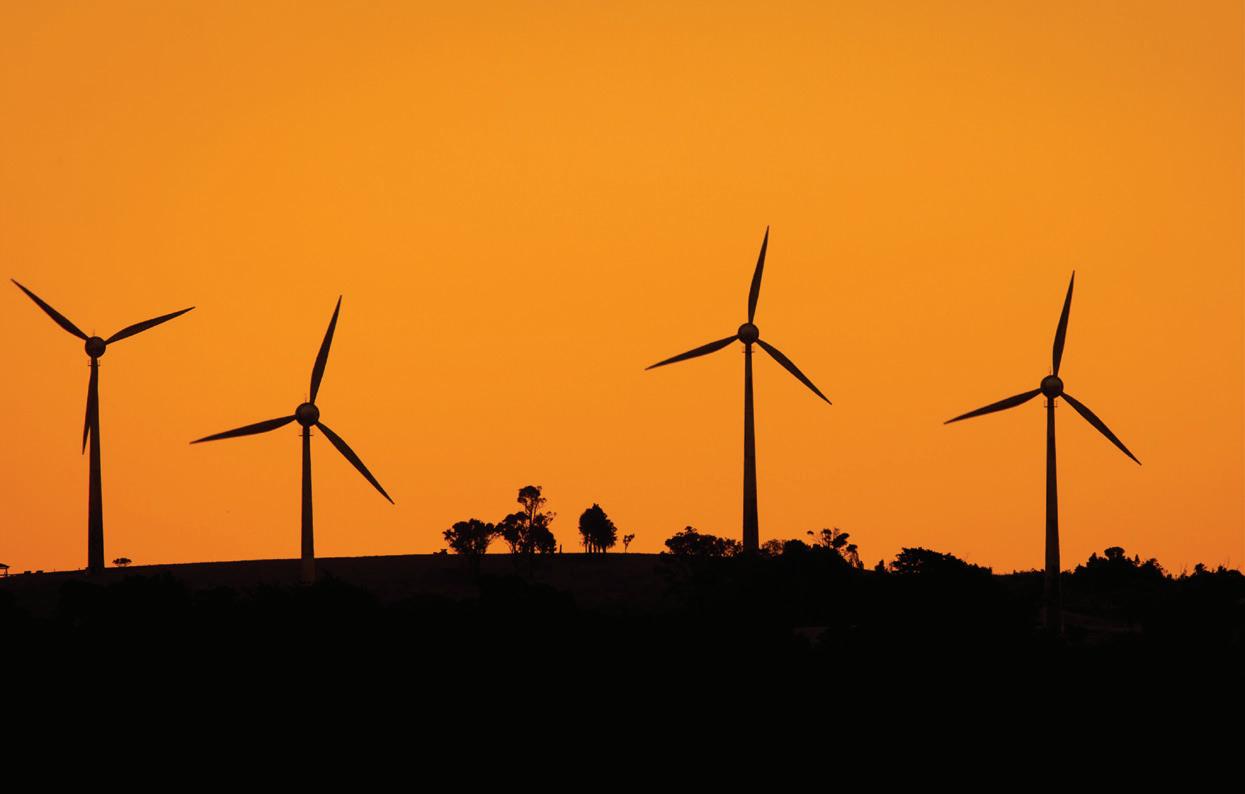
31 WIND
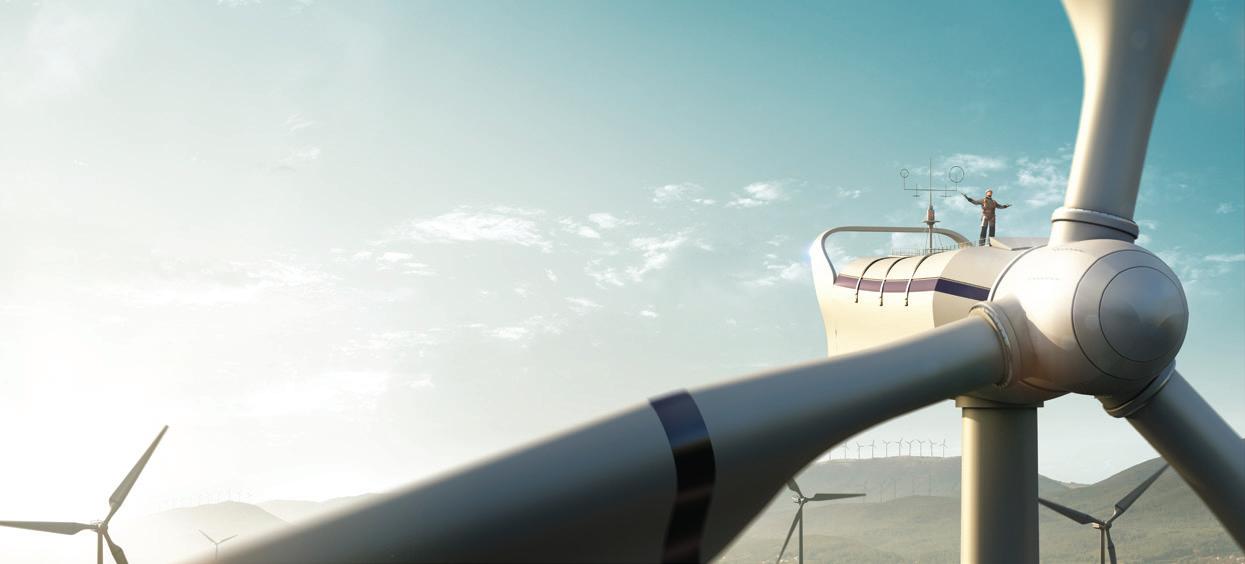
ENHANC E YOUR TURBINE MAINTENANCE WITH THE BEST SERVICE TOOLS
Working with a trusted service partner is critical when looking to extend the life of existing wind turbines. Equally important is ensuring that high-quality, tailor made service tools are also employed, to ensure that any maintenance works will go the distance.
Wind turbines can have a lifetime of between 20 and 25 years – but to ensure an installation meets this time frame, it is critically important that a reputable operator is engaged to maintain the equipment. It’s equally important that operators use proper service tools when undertaking this work.
Failure to do so can have dire consequences – the most serious of these being the need to replace wind turbines before their expected service life. This can have a devastating impact on the overall economic viability of a wind development.
Altra Motion is a leading multinational designer and manufacturer of innovative products used in the maintenance of wind turbines. Below we are highlighting some of the tools that are currently being used in Australia – and around the world – by Altra Motion to help developers extend the life of their existing wind turbines.
Disc resurfacing tool
The yaw system in wind turbines has the essential role of orientating the nacelle towards the wind and holding it in position. Performing both stopping and holding functions, the brakes are under constant use and are required to operate reliably. The condition of the brake disc surface is key to the brake system’s performance – it must be smooth and remain free from damage.
Altra Motion has developed a new solution to quickly restore operation – the portable disc resurfacing tool. This consists of a milling machine that quickly repairs both sides of the disc uptower. The tool is extremely compact and lightweight, allowing it to be easily transported to the top of the wind turbine. The disc resurfacing tool is mounted utilising one of the yaw brake mounting positions.

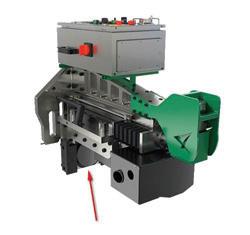
We’ve already touched on the essential function yaw brakes provide in a wind turbine, but what we haven’t discussed is the fact that these brakes are heavy and challenging to maintain in the field.
Recognising this fact, the team at Altra Motion developed a solution to make the maintenance of yaw brakes a simpler process. The result is the yaw brake lifting and installation tool, which allows yaw brakes to be maintained uptower – saving valuable time and money.
Owners who use the yaw brake lifting and installation tool on their developments are cutting service time by up to 50 per cent, which in turn reduces downtime, running costs and technician fatigue.
Yaw noise reduction tool
One of the other challenges associated with yaw brakes is the noise that they create – in fact, brake noise can be a significant contributor to the noise produced by wind turbines.
To help turbine operators, Altra Motion developed a solution that can be applied to the majority of installations, an anti-glazing groove.
By cutting a specially-shaped groove into the brake disc it is possible to prevent glazing from occurring in the future. The groove does not increase brake pad wear significantly, but it does help to remove the build-up of powdered material which contributes to glazing.
Over an 18-month period, Altra Motion modified 25 wind turbines belonging to one of their clients, adding the new grooved brake discs on units from several different original equipment manufacturers. Zero noise has been reported since the upgrades were completed.
State-of-the-art turbine solutions
To help optimise service life, Altra Motion’s products are designed and developed through significant R&D, and lengthy field testing. Altra Motion manufactures products under world-renowned brand names including Svendborg and Stromag brakes. Around the world, they are considered state-of-the-art for all modern medium and large wind turbines. Altra Motion’s superior quality components are built to handle the stresses of wind turbine applications and are engineered to last for decades.
Altra Motion is proud to be an OEM service partner to Australian wind customers, offering genuine, original spare parts and service. The company unites decades of engineering experience, traditional craftsmanship, and innovation excellence to support a safe, sustainable, and economically viable renewable energy production.
To watch a video outlining the range of services and equipment available from Altra Motion, head to www.altramotionrenewables.com.au
Yaw brake lifting and installation tool
September 2021 ISSUE 15 www.energymagazine.com.au
32 WIND SPONSORED EDITORIAL
The yaw brake lifting tool. Altra Motion’s disc resurfacing tool.

































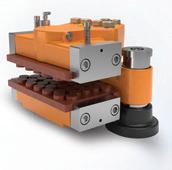
























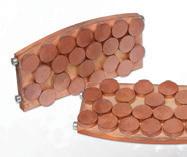

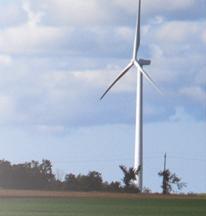
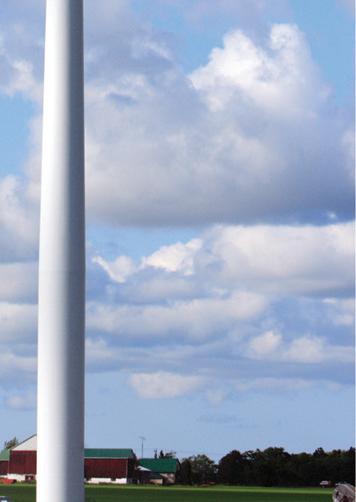
THE ROLE OF GAS PIPELINES IN AUSTRALIA’S FUTURE ENERGY SYSTEM
 Tby Rob Wheals, CEO and Managing Director, APA Group
Tby Rob Wheals, CEO and Managing Director, APA Group
Pipelines have long been the backbone of Australia’s energy system, and as Australia continues on its path to a clean energy future, our existing network will have a critical role to play for decades to come.
he shocks in electricity generation over winter in Victoria and Queensland were reminders of why we are so heavily reliant on gas.
When it comes to our energy mix, gas is the workhorse. It can be turned on in minutes, and can stay on for days, giving it a unique ability to provide firming in Australia’s energy mix.
Indeed, these events, including a coal outage in Queensland, flooding at Yallourn in June and technical issues that impacted production at the Longford gas plant in July, along with cold weather, underscored the critical role that gas plays across the national electricity market.
It was gas and gas infrastructure that stepped up to provide secure supply in real-time in response to this perfect storm of events.
When the production dipped at the Longford gas plant in July, it was the flexibility of APA’s 7,500km of interconnected gas transmission pipelines that form the East Coast Gas Grid that enabled us to get gas from the north to the south – helping address the shortfalls while ensuring the lights and the heaters of Victorian homes stayed on.
That’s because our gas infrastructure enables us to seamlessly move gas throughout eastern Australia, anywhere from Otway and Longford in the south, to Moomba in the west and Mount Isa and Gladstone in the north, maximising every ounce of capacity to support gas generation.
Even as coal is retired and renewables penetration accelerates, the firming role of gas generation will be critical to ensure the stability of the electricity grid.
Gas will continue to be critical to ensure we can keep their lights on when the sun isn’t shining and the wind isn’t blowing, helping to ‘firm-up’ the energy grid.
But while gas will continue to play a critical part in our nation’s energy mix, APA also understands that there are opportunities in supporting the development of technologies that can support Australia’s transition to a low carbon economy.
And as new technologies come online – like hydrogen and biogas – it will again be gas infrastructure that will be critical to getting into homes and businesses.
As we look ahead to 2050 and beyond, the gas industry is well placed to diversify and deploy decades of knowledge, capability and critical infrastructure to play a leading role in developing the low emissions technologies of tomorrow, at scale, and to support our own ambitions for a net zero future.
Indeed, a recent Frontier Economics study showed that continuing to use gas infrastructure can reduce emissions at about half the cost to customers than electrifying the services provided by gas.
It’s something that APA is working to support by getting ready now to support the carriage of different forms of gas in our pipelines and by investing in projects that will support the development of a clean hydrogen industry in this country.
September 2021 ISSUE 15 www.energymagazine.com.au
34 GAS PIPELINES

When it comes to hydrogen, it is absolutely clear that Australia has a natural competitive advantage.
While there are economic challenges, and the science of developing a clean hydrogen economy continues to develop, we are a step ahead with an abundance of wind and solar to power the production of renewable “green” hydrogen and an existing network of pipelines potentially capable of transporting hydrogen for domestic use or export.
APA’s 15,000km of gas pipelines not only connect our cities and regional areas, but they are linked and adjacent to some of the best geographical locations for hydrogen production in the country, such as renewable energy zones.
That’s why we’ve partnered with the Future Fuels CRC and Wollongong University, in a world-leading partnership, to help us understand the capacity of our own transmission network to transport hydrogen.
We have a project underway investigating the conversion of a section of gas pipeline in Western Australia to 100 per cent hydrogen. And while there is more work to do, the early testing results are positive.
This pilot project was APA’s first project under our Pathfinder program – a new initiative that will help unlock energy solutions of the future – and would make the Parmelia Gas Pipeline one of only a few existing gas transmission pipelines in the world, 100 per cent hydrogen-ready.
The launch of the Parmelia Gas Pipeline pilot project follows APA’s continued progress towards a sustainable future, including APA’s ambition to achieve net zero operations emissions by 2050.
As a proud Australian business, we are thrilled to be bringing international best practice to Australia in this national first, which we expect will test and prove the capacity of the existing gas transmission pipeline network to transport hydrogen in pure form or blended with natural gas.
With billions of dollars invested in gas infrastructure across the country, it makes sense to look at ways to use our existing energy infrastructure to support Australia’s transition to a low carbon future.
The Parmelia Gas Pipeline project will be completed in three phases, including: research and testing of the material for embrittlement in the laboratory; development of safe operating guidelines, and full-scale testing on-site.
In an Australian-first, a new laboratory is being established at Wollongong University to test materials, which are representative of the pipeline, under pressurised hydrogen gas conditions.
After proving the pipeline is hydrogen-ready, we will then need to consider ongoing work with potential producers and customers to understand the infrastructure and connection requirements to commission the pipeline as a hydrogen service.
The pilot project results will also support decision-making for the potential transition of other APA assets to be hydrogen-ready.
The energy transition is underway and APA is investing and adapting but in the meantime, gas is playing a critical role in grid stability. The shocks we experienced during winter underscore the role that gas plays in grid stability and reliability.
So, while the industry is rolling up its sleeves to support the development of low emissions technologies that can steer Australia’s energy transition towards a net zero pathway, we should be in no doubt about the critical role gas will continue to play in our nation’s energy mix.
www.energymagazine.com.au September 2021 ISSUE 15 35 GAS PIPELINES
Alex Gonzalez, Laboratory Technician, University of Wollongong (from left), and Dr Klaas van Alphen, Research and Innovation Manager, Future Fuels CRC.
DELIVERING THE FUTURE OF GAS THROUGH AUSTRALIA’S
MOST COMPREHENSIVE GREEN HYDROGEN DEMONSTRATION
The $15 million Western Sydney Green Gas project is a five-year trial that will convert solar and wind power into hydrogen gas, via electrolysis, which will then be stored for use across the Jemena Gas Network in New South Wales, the biggest gas distribution network in Australia. Zinfra, a leading engineering, project management, construction, operations and maintenance services provider, is Jemena’s project delivery partner, helping to execute the innovative project, which will explore how existing gas infrastructure can play a significant role in a greener energy future.
Jemena’s project will be co-funded by the Australian Renewable Energy Agency (ARENA) who has committed $7.5 million in funding for the project. If the demonstration of hydrogen blending in the gas network, storage and electricity generation as ancillary service is successful, the solution could be expanded and replicated across Australia.
The project is also being enabled for cylinder filling with the aim to refill tube trailers with hydrogen to be utilised off-site for public and private fuel-cell electric vehicle (FCEV) opportunities, making renewably-generated hydrogen available to the NSW vehicle industry.
Renewable Project Manager, Jarrod Irving, from Zinfra’s Gas Projects team said that by working with Jemena on Australia’s most comprehensive green hydrogen demonstration project, Zinfra was not only able to understand the future potential integration of hydrogen within existing gas networks, but also use the experience to upskill its field force in working with hydrogen.
“We are currently going through a massive change in the energy landscape, and hydrogen could provide a solution to the energy trilemma of reliability,
affordability and sustainability – through networks supplying decarbonised gas to consumers and as an energy storage mechanism,” Mr Irving said.
“This transition is well supported within Zinfra thanks to its leading capabilities across both the electricity and gas sectors, in which hydrogen will play a significant role, whether it be through intermittent storage, electrical generation or network injection.
“Given this, we wanted to ensure that the project wasn’t treated just as a trial, but as an opportunity to expand our capabilities and upskill our workforce.”
As part of the project, Jemena purchased New South Wales’ first electrolyser which converts solar and wind power into hydrogen gas through a process called electrolysis.
Hydrogen produced by the electrolyser will be stored within a 340m long, 500mm diameter buffer store pipeline – which can store approximately 120kg of hydrogen (approximately 4MWh of onsite storage) – before injection into the secondary gas network or generation of electricity through a microturbine or fuel cell to demonstrate the flexibility of hydrogen within future energy networks.
Using industry experience to achieve the right
outcomes
The facility design also offered unique challenges to overcome, one of those was the application of Australian Standards. The standards for piping and hazardous areas, already cover hydrogen, however, the Australian Standard for transmission pipelines (our hydrogen pipeline acts as a buffer storage facility) specifically excludes hydrogen.
This meant that Zinfra, with the support of its engineering design consultant GPA Engineering, had to utilise a hybrid of two standards for the buffer store pipeline –AS2885 for general pipeline design and ASME B31.12 for specific material and weld considerations with respect to interactions with hydrogen gas. The pipeline material used is similar to the Jemena Gas Network and will allow Jemena to understand the future implication of hydrogen within the gas network.
Construction was undertaken in partnership with Wasco Pty Ltd and commenced in early 2021 with the first green hydrogen produced in May 2021 as part of the electrolyser safety testing in the lead up to commissioning. As commissioning is completed and the facility moves to operation, hydrogen will begin to
September 2021 ISSUE 15 www.energymagazine.com.au
36 GAS PIPELINES SPONSORED EDITORIAL

be blended into the Jemena Gas Network in NSW in the second half of 2021.
Safety systems exist within Zinfra for the standard day-to-day operations around managing natural gas, however, hydrogen acts differently. Mr Irving said that by leveraging its relationship with Jemena’s project partners, the project and operations team investigated how safety systems are applied across the industry. As safety is Zinfra’s number one priority Zinfra will be applying this knowledge with the implementation of new processes and procedures developed to minimise safety risks associated with the new hydrogen facility.
“It was decided that new systems be developed, including a Hydrogen 101 training program and new hydrogen permit system, to ensure the workers we have attending hydrogen facilities understand the way hydrogen works and how to safely complete maintenance tasks on hydrogen equipment,” Mr Irving said.
“The hydrogen permitting system ensures tasks can be completed safely by allowing operational personnel experienced and trained in dealing with hydrogen to open hydrogen work permits. All training is completed and overseen by a registered training organisation with certificates provided to our personnel.”
Application of novel technology
The application of electrolysis is not new, however, utilising large-scale electrolysers to produce hydrogen is part of an emerging industry which is supported by a developing supply chain. This was severely impacted during the first wave of the COVID-19 pandemic and
had to be managed to avoid impacting the project delivery. In addition, the Zinfra team managed lockdowns and air travel restrictions to work with the supplier to successfully complete Factory Acceptance Testing via video communication.
Zinfra prides itself on being responsive, flexible and collaborative – all essential attributes when working on a project that will feature several Australian and world firsts, including:
» The world’s first renewable hydrogen pipeline
» Australia’s first micro turbine to run on hydrogen and power the grid
» The first fuel cell in Australia to power the grid
» The first direct injection of hydrogen into a steel pipeline and natural gas blend
Mr Irving said that while Zinfra uses its experience and expertise in the power and gas sectors to deliver successful project outcomes, it also embraces continuous learning and improvement.
“Projects generally carry risks and complexity no matter how big or small, however the Western Sydney Green Gas project included some very significant challenges, in particular the application of novel technology and implementation of many firsts within Australia,” Mr Irving said.
“Thanks to the support of a strong project team and project partners including GPA Engineering and Wasco Pty Ltd across the engineering and construction aspects, we have been able to overcome these challenges and deliver a facility that is the most comprehensive green hydrogen demonstration project in Australia.”
A collaborative approach to decarbonisation of the gas network
Mr Irving said that the project showcases Zinfra’s commitment to building and maintaining genuine partnerships with its suppliers, clients and communities, as well as making a positive contribution to Australia’s energy infrastructure. This includes developing key relationships across the energy industry, including working with Endeavour Energy.
“The project has demonstrated Zinfra’s broad capabilities to manage complex stakeholder requirements while ensuring key project objectives are maintained,” Mr Irving said.
“This includes the project team working with industry partners to support knowledge sharing opportunities and lessons learnt to enhance the reputation and application of hydrogen within the energy industry to support the commercialisation of hydrogen.
“Zinfra is committed to supporting renewable gas solutions with a dedicated team in place to work on the many emerging opportunities for renewable gases across Australia to support the energy transition.”
The views expressed herein are not necessarily the views of the Australian Government, and the Australian Government does not accept responsibility for any information or advice contained herein.
www.energymagazine.com.au September 2021 ISSUE 15 37 SPONSORED EDITORIAL GAS PIPELINES
ROOM FOR IMPROVEMENT: AUSTRALIA AND GERMANY SWAP NOTES ON ENERGY EFFICIENCY REFORM
Australia and Germany could benefit from swapping tactics when it comes to the energy efficiency of buildings, according to a collaborative report released by Australia’s Energy Efficiency Council (EEC) in June. Australia earns global praise for the ambitious energy efficiency standards of our commercial buildings, but our residential buildings are lagging far behind. Leading policy experts have suggested that borrowing from Germany’s model for incentivising the energy efficiency of residential buildings could help round out the performance of Australia’s own building stock.
Australian and German policy experts that recently took on the challenge of energy efficiency in residential and commercial buildings have urged further collaboration and knowledgesharing between the two nations.
Despite German and Australian governments both placing value on energy efficiency as a smart means for emissions reduction, the two nations have completely different success stories when it comes to improving the efficiency of commercial and residential buildings.
The collaborative report, entitled Further, faster, together: Opportunities for collaboration between Germany and Australia on energy efficiency in buildings, published by Australia’s own Energy Efficiency Council, through funding from the German Federal Ministry for Economic Affairs and Energy (BMWi), explores the learnings each country can take from the others approach to energy efficiency.
First conceived by the Sub Working Group of the Australia-Germany Energy Working Group, the international collaboration presented its findings in June, with key recommendations for improving energy efficiency in buildings across both the residential and commercial sectors.
By instead delivering efficiency incentives via charismatic financing partners, such as commercial and savings banks, the German Development Bank ensures that customers receive the pitch for efficiency incentives while in the very act of financing their new home or next major renovation.
Perhaps the last key factor underpinning Germany’s successful financing model is the nation’s creation of a ten thousandstrong pool of certified energy consultants.
Customers must engage with one of these energy consultants to receive any of the German Development Bank’s incentives, again ensuring that parties on both sides can be more confident that financial commitment is being matched with effective results.
Only up from here: Australia’s existing residential buildings
The EEC found that Australia’s estimated nine million existing residential buildings have shown stalled progress when it comes to energy efficiency, warranting close consideration of the policies implemented in Germany.
When it comes to minimum efficiency standards, Australia’s Nationwide House Energy Rating Scheme (NatHERS) does provide new homes with an energy efficiency rating based on thermal efficiency.
However, work is still ongoing to importantly expand NatHERS to cover existing homes. Policy makers have also noted that developing energy efficiency standards for rental properties could also help address stagnating energy efficiency in existing homes.
Even if NatHERS is expanded into a nationally recognised rating system that covers the efficiency of existing buildings, Australia could still learn a lot from the German Development Bank’s successful financing model, as well as Germany’s deployment of energy consultants, who boost confidence among both customers and financiers.
Interestingly, there have been recent signs of potential shifts towards the German model in Australia’s financing policy.
In 2020, the CEFC, described by the EEC as Australia’s green bank, worked with a private retail bank, Bank Australia, to roll out the Energy Home Loan
program, which discounts interest rates for homeowners that reach a certain degree of energy efficiency.
Bolstering the CEFC’s funding to set up programs with other retail banks, alongside the expansion of NatHERS to cover existing buildings, would set Australia on the right path for a more energy efficient residential building stock.
Commercial buildings: learning from Australia
A second recommendation of the EEC report relates to commercial building stock. In contrast to the national trends in residential buildings, the EEC found that Australian policies relating to commercial building efficiency are outperforming Germany’s efforts.
In fact, the EEC found that the energy intensity of Australian commercial buildings is about 70 per cent of the energy intensity found across Germany’s commercial buildings.
This statistic alone is grounds for German policymakers to closely consider Australia’s superior approach for achieving energy efficiency in commercial buildings.
Australia’s commercial building efficiency: the NABERS effect
The EEC report has found that energy efficiency in Australia’s commercial building stock is built upon a highly successful building performance rating system, the National Australian Built Environment Rating System (NABERS).
According to the EEC, NABERS-related buildings have saved “$1 billion in energy costs” since the scheme’s inception in 1998, with a key advantage being how “ratings are tailored to particular types of commercial buildings” to allow fair and competitive comparisons.
September 2021 ISSUE 15 www.energymagazine.com.au
38 ENERGY EFFICIENCY

Importantly, clever government policies have continued to allow NABERS rating to become the effective means of pushing for efficiency in the commercial sector.
In 2005, the Australian Government restricted its procurement policy to buildings with an above average NABERS rating, while in 2011, buildings over 2,000m2 were required to report their NABERS
Energy score at point of sale or lease.
The EEC found that the success of Australia’s successful NABERS Energy rating system has sparked international interest, with both New Zealand and the United Kingdom adopting the rating system.
Germany’s commercial efficiency problem: no comparison, no competition
The EEC found that German commercial buildings are estimated to cause 47 per cent of emissions in the building sector, despite making up just 13 per cent of Germany’s total building stock.
The EEC concluded that a number of factors see Germany outperformed by Australia when it comes to commercial buildings. The Energy Performance Certificates (EPC) used to assess building performance in Germany are not easily comparable, in contrast to Australia’s competitive NABERS system.
Furthermore, European Union (EU) restrictions prevented commercial buildings from accessing German efficiency upgrade incentives until only recently. With the implementation of a NABERS rating system or equivalent, Germany could leverage market competition to ramp up the energy efficiency of its commercial building market.
The EEC found that Australian policies relating to commercial building efficiency are outperforming Germany’s efforts.
39 ENERGY EFFICIENCY

WHY ENERGY STORAGE IS AN ESSENTIAL PART OF A SMART ELECTRIC GRID
There is no doubt that the electricity grid of the future will be greener than it is today. Intermittent renewable energy sources, with solar and wind at the fore, are gradually taking over from fossil fuel generation in grids around the world.
But there are two other attributes of the grid of the future that are just as important, if less widely acknowledged. One is that tomorrow’s electricity networks will have to be much smarter than they are today. The other is that energy storage, at all scales, will play a key role.
The requirement for greater intelligence in the grid is easy to understand based on the growing need to match intermittent renewable energy generation with fluctuating patterns of demand.
The amount of solar or wind energy available at any given point in time depends on environmental conditions and cannot be increased at will to meet demand peaks.
But intelligent grids can channel the available energy to where it is needed most, while throttling back consumption on assets such as freezers or air conditioning units that do not need a constant supply of electricity.
This practice, known as demand response, is already being used in grids across Europe and North America. Moves to establish it in Australia kicked off last September on the back of consultation papers by the Energy Security Board and the Australian Energy Market Commission. However, demand response alone will not be enough to keep future grids in balance. Switching off a few large electric loads may help solve some of the grid’s imbalances, but for more stable operation it will be necessary to keep some energy in reserve. That’s where energy storage comes in.
Huge battery plants such as the Hornsdale Power Reserve in South Australia can not only add multiple megawatts of power to the grid in times of need, but also deliver valuable ancillary services to make sure the frequency and voltage of the electricity network stays within reasonable limits.
And while Australia lags in the implementation of demand response, when it comes to energy storage the country is a
world leader. For years, Hornsdale was the biggest battery system in the world.
Although that accolade has now passed on to the US, Australia could be set to regain the title in future thanks to a project in the New South Wales Hunter Valley that is eight times bigger than Hornsdale.
The CEP.Energy Kurri Kurri plant is just one of many mega batteries planned for the National Electricity Market.
And as Australia’s electricity networks get greener, they won’t just need mega projects but batteries of all sizes, including residential systems and larger units for commercial and industrial use.
In fact, the key to a smart future grid will be to have appropriately sized energy storage assets in all locations, from the average household and office right up to the transmission network. Without them, most of that solar and wind power could simply go to waste.
For more information on energy storage and the role it will play in the smart grid of the future, download Pacific Green’s free guides to energy storage at www.pacific.green/es-guides
September 2021 ISSUE 15 www.energymagazine.com.au
40 ENERGY EFFICIENCY SPONSORED EDITORIAL

The Pacific Green Approach
Pacific Green Energy Storage Technologies delivers industry leading expertise gained from the deployment of hundreds of megawatts of capacity globally.
Wherever you are in the world, we can provide a full review and consultancy service to assess your requirements, deliver a full implementation and commissioning service, and make sure you benefit from fully automated, trouble-free operation with one of the most advanced battery systems on the market.
info@pacificgreen.tv
www.pacificgreen-energystorage.com
Leading Energy Storage

Evaluating your energy storage battery return on investment.
We’ll help you identify applications that can drive value and deliver a quicker payback on your capital outlay.
Delivering fast, effective installation and commissioning.
Once you’ve chosen the right system for your business, we’ll install the battery, enclosure and control software on a turnkey basis.
Guaranteeing trouble-free operation.
We offer the latest in energy storage battery technology coupled with a range of system-level guarantees, giving you absolute peace of mind.
Part of the Pacific Green Technologies Group
Grid Scale / Co-Located / Commercial & Industrial + + + Download our free guides to energy storage pacific.green/es-guides
AUSTRALIA’S FIRST GREEN HYDROGEN PLANT IN A REMOTE POWER SYSTEM
Horizon Power is building Australia’s first renewable hydrogen demonstration plant in a regional power system in the regional Western Australian town of Denham, with operation scheduled for early 2022.
Hydrogen is tipped to be a game-changer in the rapidly transforming global energy sector.
With the right strategy and investment, industry experts believe it could be Australia’s next big energy export.
Predictions are that hydrogen equipment costs will decline by up to 70 per cent by 2030, driven by larger market volumes and use of the equipment across several applications, meaning hydrogen fuel cell generators may become viable alternatives to both diesel generators and batteries.
The CSIRO’s HyResource report of May 2021 reflects more than 60 pilot projects at various stages of development across Australia. Regional hubs are emerging where there are existing ports, access to electricity networks and renewable energy sources, as well as the available technologies.
As the only vertically integrated energy utility in Australia, government trading entity Horizon Power operates across the full energy supply chain, providing generation, distribution, transmission and retail services. Spanning 2.3 million km2, it is responsible for the largest geographical catchment of any Australian energy provider.
Horizon Power manages a total of 38 systems across regional and remote Western Australia, including 34 regional power systems tailored to meet the needs of some of the most isolated remote communities in the world.
To address the challenges associated with this diverse servicing area, Horizon Power is making significant investments in its renewable energy capability, incorporating rooftop and large-scale solar, household and large-scale batteries and distributed energy resource orchestration and expertise. It is also leading technical trials and pilot programs, exploring innovative ways of providing more sustainable power to regional and remote communities.
Many of the towns serviced by Horizon Power are in areas where conditions for renewable generation are favourable and excess renewable energy can potentially
be used for hydrogen production.
One such town is Denham, close to 1,400km from Perth in Western Australia, which is about to become home to a green hydrogen demonstration plant.
Power to Denham’s 750 residents is currently provided through a combined wind generation and diesel system, with wind supplying around 30 per cent of demand. Both components are nearing the end of their operational life.
The requirement for a power system upgrade, combined with favourable weather conditions, land availability, water infrastructure capacity and community sentiment, make the location of Denham the ideal candidate for a pilot of this nature.
The project will be a first-of-its-kind demonstration which will test the technical capability of hydrogen as a dispatchable power source in remote microgrids in anticipation of the technology becoming cost competitive in the future.
“The aim is to trial the technology from both a technical and commercial perspective to understand whether green hydrogen can be used as a base load within our power systems,” Horizon Power Chief Executive Officer Stephanie Unwin said.
“This technology has the potential to be an environmental game changer for many remote towns in Western Australia and other similar locations around Australia, and allow greater uptake of reliable cleaner, greener renewable energy sources in the future.”
The Denham Hydrogen Demonstration Plant
The Denham Hydrogen Demonstration Plant will be an end-to-end demonstration incorporating green hydrogen into a microgrid with solar, battery, wind and diesel. The plant is expected to generate up to 526MWh of renewable electricity per year, the equivalent energy used to power up to 100 homes in the town of Denham.
The project will deliver a 704kW solar farm, 348kW electrolyser, hydrogen compression and storage, and a 100kW fuel cell. Energy from the dedicated solar farm will be used to power the electrolyser to produce hydrogen, which will be compressed and stored on site in a

pressurised system for later use in the fuel cell to deliver electricity.
“This is a ground-breaking trial which will build on the business’s expertise, taking the integration of renewables to the next level by creating green hydrogen to use as an electricity supply,” Ms Unwin said.
Pacific Energy and two of its subsidiaries, Hybrid Systems Australia and Contract Power Australia, are delivering key aspects of this project alongside Horizon Power.
Horizon Power has awarded the contract to build Australia’s first renewable hydrogen demonstration plant in a regional power system to Western Australian based Hybrid Systems Australia, the integrated renewables division of Pacific Energy Ltd.
The existing aged power station assets will be upgraded rather than replaced with a new build to complement and support the integration of the renewable hydrogen demonstration plant. Contract Power Australia has been awarded the contract to upgrade the assets, as well as supply and install an additional new 640kW solar farm and battery.
The hydrogen plant equipment will be located at the existing power station site and the new solar farms will be located adjacent to the wind farm.
Construction will start in October 2021, with the plant scheduled to be fully commissioned and operational by early 2022.
The project has been supported by both state and federal governments. It has received $2.6 million funding from the Australian Renewable Energy Agency (ARENA), as part of ARENA’s Advancing Renewables Program. A further $5.7 million
September 2021 ISSUE 15 www.energymagazine.com.au
42 REMOTE POWER
The solar farm for the Denham Demonstration Hydrogen Plant.

has also been provided by the Western Australian Government as part of its WA Recovery Plan, this includes $1 million from the WA Renewable Hydrogen Fund.
A game changer for remote towns
Hydrogen is a clean source of energy and there is no doubt the development of hydrogen energy systems has become the focus of global research efforts.
Traditionally, remote communities are powered by diesel-generated microgrids. This plant is designed to demonstrate how hydrogen can reliably produce dispatchable power for our towns that are currently dependent on diesel fuel power systems. It will allow us to transition our network away from higher emission generating sources and meet our target of no new diesel generation systems from 2025,” Ms Unwin said.
“This is a world-leading trial which aims to demonstrate a future energy solution which encourages greater uptake of greener energy sources.
“We acknowledge there are multiple challenges facing operators when they set out to deliver projects like this, from gaining the required approvals to sourcing sites and capital raising.
“By creating opportunities to work with industry to trial emerging technologies such as hydrogen, we are helping to solve real-world challenges while also contributing to the broadening of industry’s knowledge and expertise.”
The views expressed herein are not necessarily the views of the Australian Government or the Government of Western Australia nor do the Australian Government or the Government of Western Australia expressly or impliedly endorse any views or information contained herein, and the Australian Government and the Government of Western Australia do not accept responsibility for any information or advice contained herein.
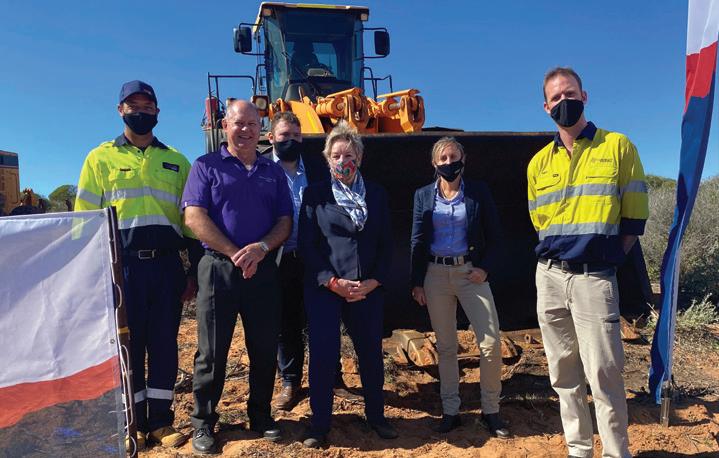

PROJECT MILESTONES
August 2020: The Western Australian Government announces $5.7 million in funding as part of its WA Recovery Plan, of which $1 million is allocated from the WA Renewable Hydrogen Fund.
November 2020: ARENA announces $2.6 million in funding to support construction of the project.
December 2020: Horizon Power awards WA based Hybrid Systems Australia, the specialist integrated renewables division of Pacific Energy Ltd, a contract to build the plant.
May 2021: Construction of the solar farm begins.
May through to October 2021: Horizon Power’s contractor Contract Power Australia undertakes upgrade works to the existing power station, as well as supply and install a new additional 604kW solar farm and battery.
October 2021: Construction of the hydrogen demonstration plant commences.
Early 2022: Hydrogen demonstration plant is scheduled to be fully commissioned and operational.
www.energymagazine.com.au September 2021 ISSUE 15 43 REMOTE POWER
Horizon Power Chief Executive Officer Stephanie Unwin.
Infographic depicting Horizon Power’s Hydrogen Demonstration Plant in Denham.
L-R: Horizon Power’s Renato Pascucci, Shire of Shark Bay’s Paul Anderson, Hon Kyle McGinn MLC - Parliamentary Secretary to the Minister for Disability Services, Fisheries, Innovation and ICT; Seniors and Ageing, Hon. Alannah MacTiernan MLC, Minister for Regional Development, Agriculture and Food; Hydrogen Industry; Horizon Power’s Stephanie Unwin and Hybrid Systems’ Mike Hall, on site in Denham in May as works commence on the hydrogen demonstration plant.
MITIGATING THE RISKS OF REMOTE WORKPLACES
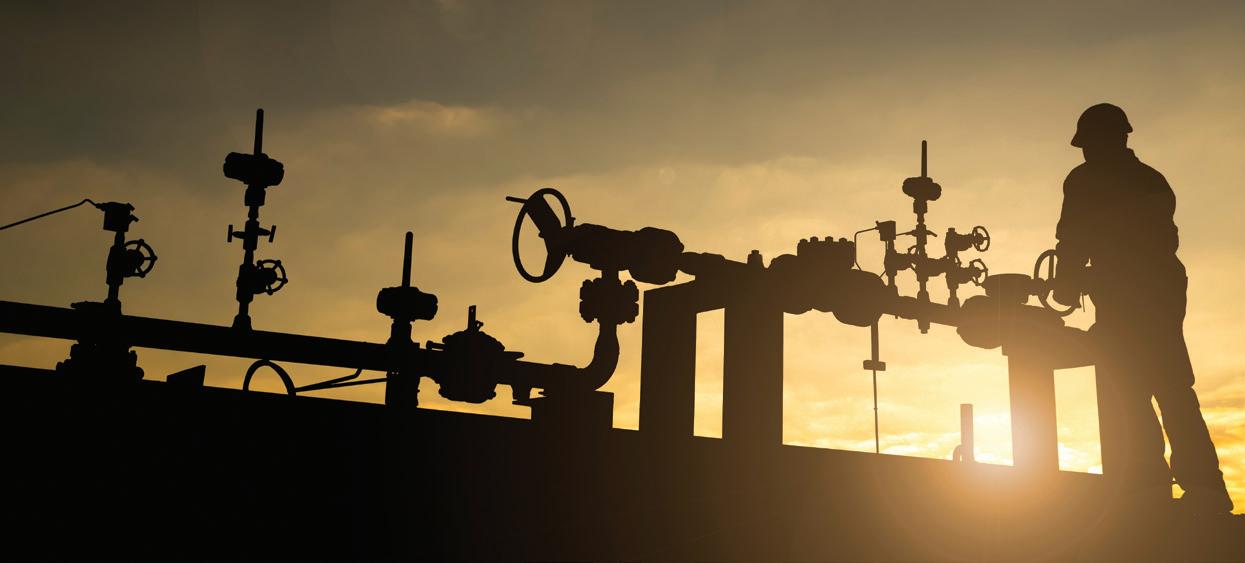
Infrastructure projects in remote Australia present unique challenges to managing site risks and creating safe worksites. Australian Private Networks (APN) connects remote worksites and employees with the outside world through fixed and portable business satellite internet and WiFi.
APN’s internet and phone services ensure critical business communications can be maintained, site safety and performance can be monitored, and workers can stay connected with their families.
Constant internet and phone services are critical to the safe operation of projects, meaning remote sites without mobile phone coverage and fixed-line internet are inherently more risky than metropolitan projects. For instance, lacking the ability to communicate with emergency services in times of emergency provides a significant risk.
With nearly two decades of experience providing remote WiFi, internet and phone solutions to Government and Enterprise, APN has identified some of the key reasons how a satellite internet service minimises organisational and staff risks.
Business continuity assurance
Satellite offers a perfect backup to primary microwave or fibre internet connections. Network downtime can be relatively common due to the isolated nature of the sites and are extremely costly – potentially resulting in service or production downtime.
The risk of disruptions from primary network downtime can be minimised using a DRP satellite solution. With DRP specific service options minimising standby costs when not in use, satellite internet is a cost-effective way of guaranteeing connection to external networks.
Worksite safety compliance
Providing an effective means of communication for remote or isolated workers means ensuring they can access

assistance from emergency services, a key requirement for a safe workplace. For permanent or semi-permanent remote sites, communications can present a costly challenge. APN’s services provide remote crews with the ongoing communication required to keep them healthy and safe.
Attract and retain talent
In today’s world, workers' access to online content and to contact family and friends is a crucial requirement in attracting and retaining employees. APN’s portable solutions are easily transportable for road crews or continuously moving sites. Mobile teams in the most remote locations can have a continuous internet and phone service.
Improve productivity and work quality
Productivity is a large concern for employers, and effective off-site management of remote work sites presents
many challenges. APN’s user-friendly fixed or mobile satellite communication solutions present a cost-effective off-site management solution to even the remotest of locations. Studies show satisfied employees are not only more productive but also have a higher quality of work.
Solutions available
Satellite communications solutions are available for permanent, semi-permanent or mobile sites with varying data packages depending on requirements. Hardware can be mounted to a permanent structure, vehicle or trailer and is also available as a standalone unit.
For more information on how APN’s satellite internet solutions can reduce your business risk, visit apn.net.au or call us on (03) 8566 8312.
September 2021 ISSUE 15 www.energymagazine.com.au 44
REMOTE POWER SPONSORED EDITORIAL
Satellite Internet for Remote Operations
Australian Private Networks supplies fixed and portable internet for remote operations, anywhere in Australia.
Our solutions include:
Unlimited data plans
Low contention rates
Fixed or portable hardware
Solar, self-sufficient options
Optional Extended Wi-Fi and Public Wi-Fi
Installation & Field Support Australia-wide
O Our solutions overcome the communications limitations of operating in remote locations
With our internet services, staff can access online business tools, operations can integrate remote monitoring tools and utilise IoT technologies.
No matter your communications challenge, we can design bespoke solutions to meet your unique requirements.
For more information contact our Corporate Sales team or visit: apn.net.au



Major Partner Contact Us 03 8566 8312
BLACK SYSTEM OR BLACK SWAN:
LEARNINGS FROM SOUTH AUSTRALIA’S INFAMOUS 2016 BLACKOUT
by Imogen Hartmann, Associate Editor, Energy magazine
Reliability stands as one of the three pillars of the energy industry’s most coveted objectives, along with affordability and sustainability. With the phrase “keeping the lights on” so often used by industry leaders and policy makers, it’s no wonder that when the lights truly went out in South Australia in 2016 it caused a nation-wide stir. As the state’s 1.7 million residents were plunged into darkness following a massive storm, one question was on everyone’s minds: what went wrong? In the first part of this series examining the South Australian blackout, we use the benefit of five years worth of hindsight to examine the events that occurred in the leadup to and during the crisis.
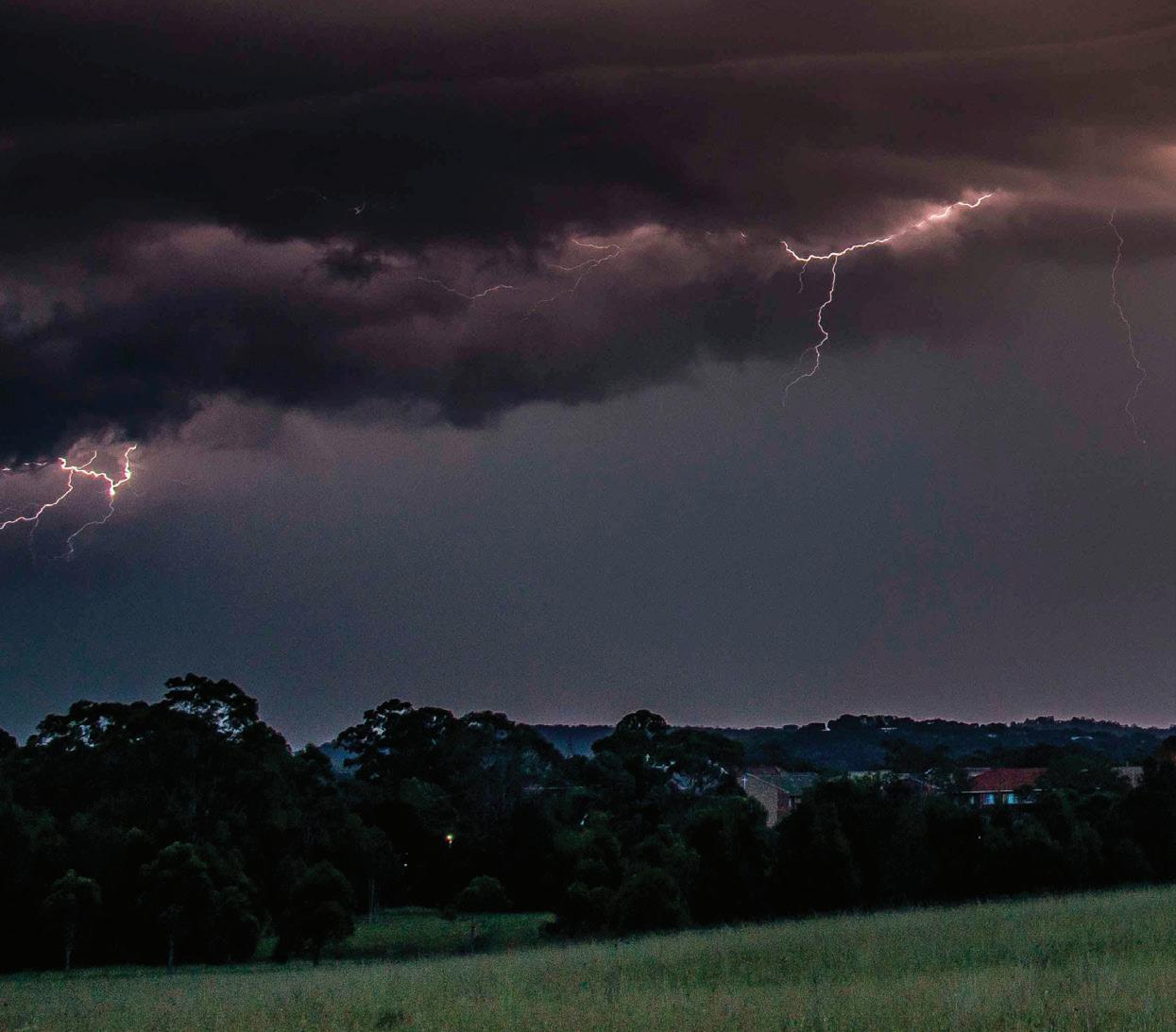
During the period 28 to 30 September 2016, a storm dubbed as a “once-in-50year” weather event tore through South Australia.
The intense low pressure system saw winds of up to 140km/h hit Adelaide, eliciting an unprecedented warning from police for workers to head home early and stay home to preemptively alleviate pressure for emergency services.
Trees were brought down in some areas, causing major damage to infrastructure and the heavy rain resulted in widespread flooding, from the Patawalonga River in Adelaide, through to the Barossa and Clare valleys.
Along with destructive winds, the super cell storms brought with them twin tornadoes that decimated northern parts of the state. 22 transmission towers that carried electricity generated near Port Augusta to the rest of the state were ripped out of the ground, and three major transmission lines were brought down.
Energy infrastructure also copped a severe amount of damage from 80,000
lightning strikes that hit the state over a short period.
As South Australia was plunged into darkness by a state-wide blackout, then Premier, Jay Weatherill, described what had happened as “catastrophic”. The event has since been described as a black swan – an unpredictable, rare event that falls outside of what is normally expected of a situation, often with severe consequences. The defining characteristic of a black swan event is a surrounding narrative that it was obvious or avoidable in hindsight.
Protection systems triggered
Two tornadoes with wind speeds in the range of 190-260km/h resulted in a single circuit 275kV transmission line and a double circuit 275kV transmission line, some 170km apart, simultaneously sustaining serious damage.
The transmission lines tripped as a result, with a sequence of faults in quick succession causing six voltage dips on the South Australian grid over a two-minute period at around 4.16pm on Wednesday 28 September.
Concurrent with a growing number of faults on the transmission network, nine wind farms located in the state’s mid-north showed a sustained reduction in power – a protection feature activation.
Protection settings in eight of these wind farms enabled them the capability to withstand a pre-set number of voltage dips within a two-minute period. As this protection feature was activated, the wind farms sustained a hefty generation reduction – 456MW – over a period of less than seven seconds.
Just as the wind farms have inbuilt protection systems, so too do the poles and wires. Generators create power, but they also affect the voltage and the frequency of the electricity network – something that requires careful maintenance in order to protect everything that’s connected to it.
When the 22 high-voltage power pylons went down, it triggered a series of automatic safety switches designed to protect the greater South Australian power network – and the rest of the National Electricity Market (NEM).
46 DISASTER MANAGEMENT
September 2021 ISSUE 15 www.energymagazine.com.au
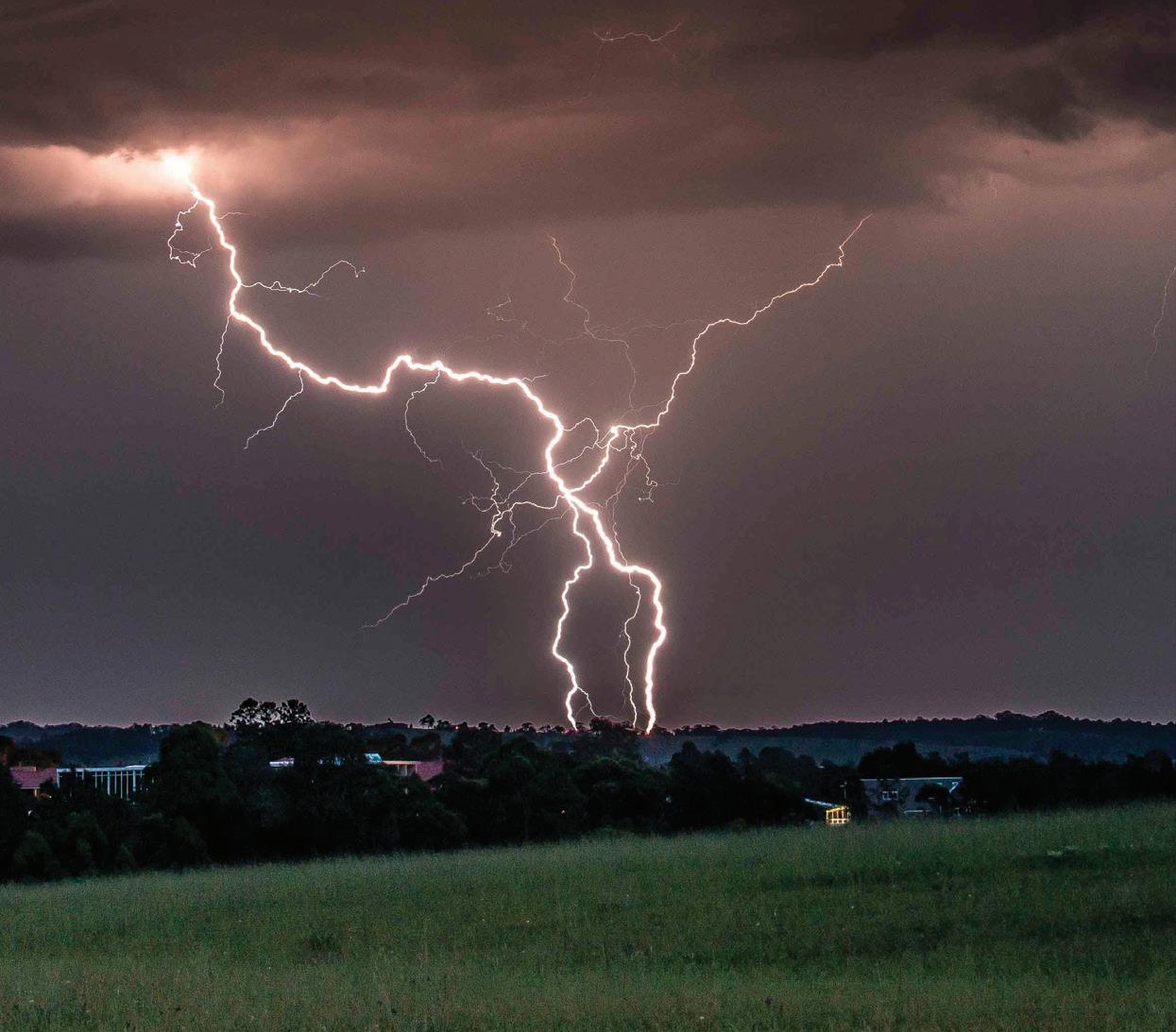
After the wind farm output dropped off, a significant increase in imported power flowing through the Heywood Interconnector then occurred. No more than 700 milliseconds after the last of the wind farms’ output dropped off, the level of flow reached on the Victoria-SA Heywood Interconnector activated a specialised protection scheme – tripping the interconnector offline.
Mr Weatherill told reporters at the time, “What happens is the system protects itself by tripping all the generators in the system and also by severing the interconnector with Victoria.”
South Australia’s power system had effectively become “islanded” from the rest of the NEM.
According to an analysis by the Australian Energy Market Operator (AEMO), Black System South Australia 28 September 2016, there was no substantial load shedding after the system separation, resulting in remaining generation that was significantly lesser than the connected
load, thereby rendering it incapable of maintaining the islanded system frequency.
The result was a total loss of power supply to the South Australia region (known as a Black System) at 4.18pm.
Repowering the system
Mr Weatherill said that following the cut off from the interconnector, there was a series of back-up generators which gradually restored power to the system.
“Once the system is balanced then power is restored,” Mr Weatherill said. AEMO reports that, following an assessment process conducted in partnership with South Australian transmission company, ElectraNet, to determine which sections of the network were safe to energise, a system restart plan commenced at 4.30pm.
This plan included restart capability from one of two contracted South Australian system restart ancillary service (SRAS) generators, and supply from Victoria via the Heywood Interconnector.
ElectraNet worked on the damaged transmission lines that posed a potential threat to public safety.
By 7pm on 28 September, the first customers began to see power being restored, and by 8.30pm the state saw restoration to 40 per cent of load capable of being restored.
Around midnight, 80 to 90 per cent had been restored, with the remaining load being gradually restored up until 11 October 2016, involving a process of bypassing fallen transmission lines.
Minutes after the initial event, AEMO made a declaration of NEM suspension within the South Australian region. This suspension wasn’t immediately lifted after the Black System event was over as there still remained uncertainties over power system operations. It wasn’t until twelve days later that AEMO lifted the suspension upon advice from the South Australian Government that its direction for suspension of the market had been revoked.
47 DISASTER MANAGEMENT
www.energymagazine.com.au September 2021 ISSUE 15
SA’s energy mix under fire
In the aftermath of the 2016 blackout, with several smaller-scale blackouts recorded across the state in the years prior, industry and governments quickly began asking the questions: could we have seen this coming? Could this have been avoided?
A lot of this speculation was prompted by South Australia’s somewhat controversial energy mix.
At the time of the blackout, South Australia’s energy mix consisted of wind, solar and gas. What was unique about the state’s energy supply at this time was that Alinta's Northern power station at Port Augusta closed in May that year, cutting coal out of South Australia's electricity production equation for the first time.
This was considered by many as a bold strategy, and aligned with the State Government’s pursuit of a power system consisting of plenty of renewables.
Former Chief Executive of the Australian Energy Council, Matthew Warren, warned at the time of the power station closure’s potential impact on the state’s back-up energy availability during peak demand times. He also said this would place a greater reliance on the state’s renewable energy generation, and the Victorian interconnector for base-load power.
Mr Warren described South Australia’s energy position as “uncharted waters”, and asserted that there was a greater level of risk than ever before of blackouts.
Deputy Prime Minister, Barnaby Joyce, said on Sydney radio station 2GB shortly after the event, “Obviously we know that South Australia has had a strong desire to become basically all renewable energy and the question has to be asked: does this make them more vulnerable to an issue such as what happened last night?”
Mr Joyce criticised that the state was in a more vulnerable energy position, which had made a total blackout more likely.
Then South Australian Senator, Nick Xenophon, told reporters that the state relied too heavily on baseload renewables rather than baseload power such as gas, before calling for an independent inquiry into the outage.
Then Federal Energy Minister, Josh Frydenberg, said on a 7.30 report, "We have a COAG energy council which I chair and I'm proposing to bring those members together as soon as possible to get to the bottom of exactly what has occurred and what needs to be done to ensure it doesn't happen again."
Renewables to blame?
Mr Weatherill rejected the notion that the state's high use of wind power or the shutting of the coal-fired stations had any impact on the severity of the power failure. Instead, he maintained that the system had reacted as it was designed to.
“This would happen to any system anywhere in the world if they had a similar circumstance,” Mr Weatherill said.
Some energy experts backed this sentiment, stating that even if coal-fired stations had still been operating, they too would have dropped offline and succumbed to the cascading failure that tripped the generations.
Dylan McConnell, Research Fellow –Energy Systems, Climate & Energy College and Energy Transition Hub, said, “Having those thermal generators there wouldn’t have helped at all.”
Roger Dargaville, Deputy Director at Monash Energy Institute, said, “These kinds of failures in the NEM (which covers the five eastern states) are extremely rare. The NEM experiences a range of extreme weather on a regular occurrence and a vast majority of the time copes well.
“The system contains multiple levels of redundancy and safety mechanisms, however it is impractical if not impossible to build any complex system that is completely 100 per cent reliable.
“Providing additional redundancy to insure against such events would be extremely costly, and would still not completely guarantee against further extreme events.”
The Black Swan conundrum
Retrospective analysis is the crux of the Black Swan conundrum – with the knowledge of hindsight, it’s easy to say that the fallout from an event, unprecedented or not, could have been avoided with the right fail-safes in place. But, as Mr
27 Sep 2016
9 May 2016
4:16pm
28 Sep 2016
September 2021 ISSUE 15 www.energymagazine.com.au 48
MANAGEMENT
DISASTER
warnings issued across SA
4:18pm SA’s last coal-fired power station closes Weather
Storm, tornadoes and winds damage transmission towers
o
occurs
Wind farm output drops
System blackout

Soon after the South Australian blackout, fingers were being pointed at wind farms.
Dargaville pointed out, it can be costly and impractical to try to predict and mitigate absolutely anything that might befall our power system.
Mr McConnell explained this by saying that if South Australia could have planned for this exact weather event and subsequent power impacts, just to be hit with something different, like an earthquake. In this case, costly protections might have been put in place just to suffer the same system failure caused by another unexpected event.
Not only would a system capable of dealing with any risk scenario be very expensive, it has been suggested that black swan events can wreak havoc on an economy by negatively impacting markets and investments.
Despite the difficulty of predicting such events, the industry and public have been keen nevertheless to gain some more understanding from the South Australian blackouts to strengthen the system of the NEM, and prevent it from happening again.
System restart plan commences, NEM suspended within SA Customers start to regain power
What would follow would be a series of reports, reviews and investigations into the incident, as well as energy market rule changes to mitigate risks, and industry bodies and governments keeping a watchful eye on similar Black Swan events as they unfolded.
Stay tuned for Part 2 of this series in our November issue of Energy magazine, where we’ll take a deeper dive into the industry’s response to the crisis, report findings into the role renewables played, and examples of other black system events across the world.
4:30pm 7pm 8:30pm Midnight 11 Oct 2016
power restored
fully restored to SA & NEM suspension lifted
power restored www.energymagazine.com.au September 2021 ISSUE 15 49 DISASTER MANAGEMENT
40%
Power
90%
NEW TECHNOLOGY TRANSFORMS RESILIENCY READINESS
Hardening a power grid is a necessary but complex undertaking. Bringing the right resiliency assessment tools to bear can simplify and accelerate the process.
When Cyclone Seroja landed in April, it damaged 70 per cent of buildings in the towns of Kalbarri and Northampton. It also changed the conversation about how Australians prepare for catastrophic weather events. A team from James Cook University’s Cyclone Testing Station has recommended changes to regulations and building codes as destructive storms land ever farther south. Inevitably, the utility industry will also have to come to terms with the reality of increasing climatic uncertainty.

Whether recovering from one disaster or anticipating the next, cost-effectively enhancing the resilience of power grid structures begins with an accurate assessment of existing infrastructure health. That includes literally seeing all structural elements to assess possible weaknesses.
OsmoVision® offers an unmatched suite of cutting-edge hardware and software that can document power grid vulnerabilities and strengths like no other. This removes the need for inaccurate, labour-intensive, slow and costly measurement though calibrated pixel counting.
OsmoVision utilises a combination of proprietary LiDAR point cloud classification and imagery recognition tools to generate an accurate digital twin of utility structures. This turnkey LiDAR collection and processing system leverages the accuracy and repeatability of measurements and minimises potential data entry errors to improve accuracy, consistency, and efficiency of structural engineering analysis both at the individual structure level and when analysing entire lines.
The digital twin generated by OsmoVision enables the assessment of system resiliency by simulating its ability to withstand high-impact events. This will determine which areas of a structure above ground are more resilient and which areas are at risk of failure during a high-impact event, such as a cyclone.
To address points of poor resiliency, various hardening solutions are then simulated to support the determination of the best approach. Both resiliency analysis and pole owner business KPI’s are factored in during the hardening solution development, and the expected resiliency improvement is defined clearly for each critical KPI.
When planning for severe weather, an additional advantage of having a digital twin is the ability to anticipate the required equipment, staff, and materials needed for recovery and also where it will be required. This helps prioritise placement and staging of response-related inventory to reduce downtime after an incident.
In addition to the benefits of OsmoVision’s advanced technology, Logsys Power Services brings the expertise to support the structure owner’s decision making in matters of resiliency. Whether the need is to develop a plan and budget to implement a hardening solution, or to forecast the degradation of assets and its impact on resiliency, Logsys Power Services has experienced engineers, project managers and data scientists to answer those critical questions.
September 2021 ISSUE 15 www.energymagazine.com.au
50 DISASTER MANAGEMENT SPONSORED EDITORIAL For more information on how OsmoVision® and Logsys Power Service can assist with grid hardening, head to www.logsys.com.au


OsmoVision
Advanced Structural Resiliency Study

Cost-effectively enhance the resilience of power grid structures with an accurate assessment of existing infrastructure health.
• Generate a digital twin using our proprietary LiDAR point cloud classification and image recognition technology.
• Assess your system resiliency by simulating its ability to withstand high-impact events, such as a cyclone.
• Formulate system hardening solutions that improve your infrastructure’s structural resiliency.
(08) 9300 2950 | enquiries@logsys.com.au | logsys.com.au/osmovision an company
®
COMMUNITY BATTERIES POWERING AHEAD WITH
Community batteries are perhaps the missing size option in Australia’s energy storage toolkit. Filling a niche between residential and utility-scale batteries, community batteries empower Australian communities to make the most of a growing base of distributed energy resources like rooftop solar. To understand the big-picture obstacles faced by community batteries, we spoke with leading experts from the Australian National University’s Battery Storage and Grid Integration Program (BSGIP), Project Lead Dr Marnie Shaw and Research Fellow Dr Hedda Ransan-Cooper.
The twenty-year outlook on Australia’s energy future will continue to star decentralised renewable resources, like rooftop solar, which are predicted to increase by at least 200 per cent by the Australian Energy Market Operator (AEMO).
For Australia to get the most out of our distributed energy resources, such as rooftop solar, researchers are pointing to the critical potential of battery storage for buffering energy output.
Living between the scales of utility and household scale batteries, community batteries offer energy storage for around 100 households, with power capacities up to 5MW.
They might be anywhere between the sizes of a refrigerator and a shipping container, but don’t rule out the imprint that community batteries might have on Australia’s energy future.
Leading Australian researchers have pointed out that community batteries promote local energy stability and resilience, they are cheaper when compared to deploying single-household batteries, and they boost local hosting

capacity, increasing the amount of renewables that can be installed across our neighbourhoods.
Australia’s trial community batteries include 13 operational units installed by WA’s Western Power, as well as an emerging and collaborative project to install the first community battery in Melbourne’s CBD, led by Yarra Energy Foundation (YEF).
While trial projects around Australia are promising, researchers from the Battery Storage and Grid Integration Program (BSGIP) have detailed key regulatory and social hurdles that prevent community batteries from really taking off.
September 2021 ISSUE 15 www.energymagazine.com.au 52 DISTRIBUTED GENERATION

www.energymagazine.com.au September 2021 ISSUE 15 53 DISTRIBUTED GENERATION
Living between the scales of utility and household scale batteries, community batteries offer energy storage for around one hundred households, with power capacities up to 5MW.
It’s a match: community batteries and decentralised renewables
Australia’s base of decentralised renewables could stand to benefit from a more widespread uptake of community batteries, according to researchers from the BSGIP.
Dr Marnie Shaw, the BSGIP Project Lead, notes that community batteries are like household batteries in how they “support the grid by acting as a ‘solar soak’ during the day and reducing peak power demand later in the evening”.
But beyond boosting the hosting capacity of local solar production, community batteries offer additional opportunities and revenue streams.
A findings report released by the BSGIP project suggests that community batteries could act as nodes for managing demand and voltage issues on the distribution network, particularly felt during peak import and export times, while also securing contingency options and energy resilience for local communities.
A new tariff proposal for community batteries
Dr Shaw’s team at the BSGIP has proposed a new tariff model that recognises the local energy transactions between solar units and community batteries, addressing an existing regulatory barrier for battery uptake.
“Current electricity tariffs double-charge community batteries because the grid is used to both charge and discharge the battery,” Dr Shaw said.
“We propose a discounted tariff that would apply to energy transported over short distances.”
Unlike household battery units, which might be “off the grid” to allow charging without network fees, community battery units are typically installed in front-of-themeter: this enables community batteries to integrate and adapt to the broader network at the price of energy flow network charges.
The BSGIP’s distance-based tariff, known as the Local Use of System (LUoS) tariff, is just one regulatory change that would allow community batteries to become a far more economically viable storage option.
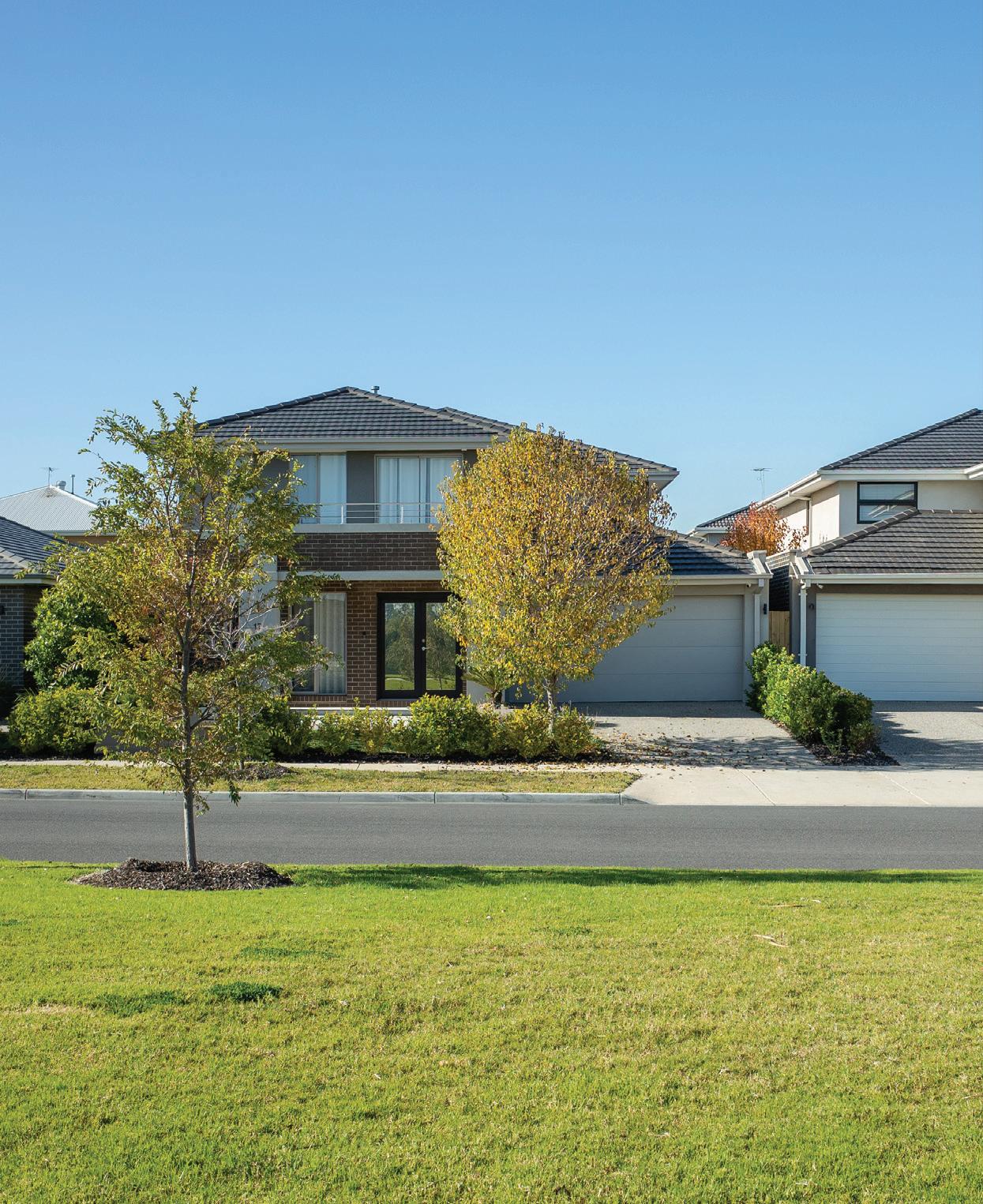
The social impacts of community batteries
Another key branch of research from ANU’s Battery Storage initiative looks at flow-on effects of community batteries on different community groups.
Dr Hedda Ransan-Cooper, Research Fellow at the BSGIP, has found that the rollout of community batteries touches on existing community values including fairness, local value and decarbonisation.
“Our research shows a significant driver for adoption of residential storage and solar more generally is a desire to speed up the decarbonisation of the energy transition,” Dr Ransan-Cooper said.
Indeed, a stakeholder report from the BSGIP has found that community batteries could open doors for new social
54 DISTRIBUTED GENERATION
groups, such as renters and households without rooftop solar, to also participate in decarbonisation.
Dr Ransan-Cooper also notes that a deeper consideration of what fairness means to different community groups would only speed up the development of policies for renewable energy transition such as the community battery scheme, noting that “instances of perceived inequality” between energy users and energy companies only exacerbate low trust in the energy sector.
The future players of community batteries
At the intersection of regulatory and social challenges, ANU’s lead battery storage researchers have closely evaluated the strengths and weaknesses of different ownership models for community batteries.
Indeed, a key take-home message from the BSGIP’s evaluation of community battery ownership options is that “Distribution
Network Service Providers (DNSPs) face regulatory barriers, retailer-owned models face trust issues, and community-owned models face logistical issues”.
Dr Ransan-Cooper emphasises that different ownership models bring different stakes of accountability, with different metrics of what a successful community battery project looks like.
One interesting ownership model studied by ANU researchers looks at how third parties such as local governments could deliver benefits to the widest range of stakeholders.
Importantly, the stakeholder coverage offered by a local government community storage project would stretch beyond rooftop solar homeowners and participating customers of a given community battery scheme.
Beyond a guaranteed return for battery storage customers, any additional revenue of a council-owned community battery could be further reinvested in local sustainability projects.
In a federal response to the potential of community storage, the Australian Labor Party announced a $200 million ‘Power to the People’ proposal to build 400 mediumscale batteries across Australia.
Undoubtedly, the critical research of ANU’s Battery Storage and Grid Integration Program will set Australia up for a smarter and fairer national rollout of community batteries, to make the most of our distributed energy sources as we continue a national energy transition.

55 DISTRIBUTED GENERATION
Community batteries could fit in easily within suburban streetscapes.
TECHNOLOGY NOT TAXES: THE PROBLEM WITH TECHNOLOGY-LED ENERGY FUTURES
By Dr Kari Dahlgren, Research Fellow, Emerging Technologies Research Lab, Monash University
Politicians love a three-word slogan, and the Morrison government’s latest oversimplification of an incredibly complex topic into three pithy words is its approach to climate change: technology not taxes. But new research from Monash University shows that getting consumers to adapt technology-led solutions that will allow better demand management will be easier said than done.
The phrase is an appeal to the right wing which has fought a carbon price for almost two decades, while admitting that at least some decarbonisation is necessary. Of course, while portraying itself as a free market solution, the policy itself involves investing significant taxpayer dollars, including $263.7 million for carbon capture and storage, a still largely unfeasible technology that is intentionally designed to prolong the life of fossil fuel industries. The phrase is also a view that technology will save us from the negative effects of climate change, and that no social or lifestyle changes are needed to achieve significant carbon emission reductions.
However, technology-led approaches to decarbonisation are likely to fail if they do not consider how technology will actually function, including how people will engage with a broad range of technologies that are proposed to address climate change.
Carbon capture and storage is not the only technology that the government is relying on to play a significant role in decarbonisation efforts. The Technology Investment Roadmap also includes a number of emerging and enabling technologies that it suspects will underlie its technology-led approach to decarbonisation, in particular forms of what are called demand management technologies. These work by shifting the
demand for electricity to times where it is plentiful and supplied by low emissions technologies, like rooftop solar.
While less controversial, these technologies are also worthy of interrogation. They include technologies like smart appliances that can be controlled remotely, either by consumers or by electricity companies through a process called direct load control. These technologies are imagined as allowing the electricity system to use automation and artificial intelligence to match household energy use to the increasingly complicated and distributed nature of electricity generation. As Australia’s energy system relies on more renewables like solar energy, energy demand must be better matched to the times that renewable energy is available.
Currently too much solar is being produced in the early afternoons, and not enough is being produced in the early evenings, at the same time that energy demand rises as people return home to begin cooking, chores, or turn on their air conditioners. New smart technologies can allow pre-cooling the house, or controlling the dishwasher remotely, in order to better match the demand for electricity with its availability from renewable sources. These can also be automated and therefore require little active involvement from households.

This is why there is so much hype around these demand management technologies and the important role they are likely to play in the energy transition. However, there is still much to learn about how people use automation in their homes and whether or not they are likely to use automated technologies in the ways that energy policy stakeholders anticipate.
The Digital Energy Futures project threeyear initiative led by Monash University draws on future-focused social science research. We aim to better understand how emerging technologies are shaping the way people live – and ultimately, the future energy needs of Australian households.
Through ethnographic research with 72 households across NSW and VIC, we discovered that technological approaches to managing energy must consider people’s complex relationships and trust issues with automation and people’s everyday priorities.
In our research with Australian households we found that smart technology enthusiasts were not very interested in using technology for energy management. The appeal of smart technology was more about the entertainment, convenience, or aesthetic improvements that it brought to the house, which may actually serve to undermine energy efficiency. Smart lights, smart speakers and internet-connected security systems were all adopted with little
September 2021 ISSUE 15 www.energymagazine.com.au
56 DISTRIBUTED GENERATION

consideration of how their cumulative use might increase energy demand, and rarely were they used for automating existing household activities. When automation was part of the use of a smart technology, it was not designed to match energy price signals, but to optimise convenience or comfort. For example, the smart functionality in air purifiers is not set to respond to energy pricing or availability, but to air quality monitors built into them, which are likely to be triggered at existing peak demand times.
It’s not all bad news though. We found that there was widespread demand for the transition to renewables, but people didn’t necessarily see technology as central to that. Instead, households that were committed to saving energy often found actions like manually switching off unused appliances, or planning around the weather, to be less complicated than automated or smart systems.
Many preferred to manually control their energy use and developed
ad-hoc practices rather than relying on the automation embedded in technologies. For example, one participant manually switched her electric vehicle charger on and off at the wall to override its automated charging function so that it better fit her routines and priorities, including to take optimal advantage of lower evening electricity prices.
We also found a willingness by people to play their part towards supporting sustainable energy futures. This was particularly true when we explained the earlier mentioned grid issues to households. Households were mostly positive about demand management programs and concepts, including demand management programs that encourage people to reduce their energy use at certain high demand times. People are currently offered a small financial incentive to take part, but we found that people who already took part in these programs didn’t do it only for the small credit on their bill, but they found that it was an important
Research shows that getting customers to manage their electricity demand to match the needs of the grid is not as simple as just providing the right technology.
opportunity to teach their children about energy, or they were motivated by a sense of helping the collective community.
Technology does have a role to play in decarbonising the electricity system, but it will also involve people buying into these technologies and responding in ways that reveal a broader social commitment to addressing climate change.
Australia should not be relying on technology to be the silver bullet solution to climate change. A technology-led approach overlooks the needed commitment of Australian households to decarbonisation. Instead, we propose taking into account the ways in which everyday life, technology and energy trends evolve and intersect. We implore the energy sector and policy stakeholders to consider new ways to co-design future digital and energy technologies that people can be productively involved in and ethically engaged with. Dr
www.energymagazine.com.au September 2021 ISSUE 15 57 DISTRIBUTED GENERATION
is a Research Fellow in the Emerging Technologies Research Lab. Kari is a social anthropologist and ethnographer interested in the social and ethical aspects of energy production and consumption in Australia.
Kari Dahlgren
DEPLOYING SPS FOR WA’S CYCLONE SEROJA RECOVERY AND BEYOND
by Lauren DeLorenzo, Journalist, Energy Magazine

In April 2021, Tropical Cyclone Seroja ripped a 1,000km trail of damage through Western Australia, leaving tens of thousands of residents and businesses without power. In an effort to restore power reliability, Western Power has accelerated a program to install stand-alone power systems (SPS) in the region.
The storm ravaged the town of Kalbarri, with an estimated 70 per cent of structures suffering severe damage. With an affected area as large as Tasmania, residents went days sheltering by candlelight, purchasing their own generator fuel and traveling long distances for hot showers.
Around 20 per cent of the region’s power network was damaged during the storm. In the immediate aftermath, 31,500 homes lost power in Kalbarri and neighbouring towns of Geraldton, Northampton, Dongara, Port Denison and Mullewa. One week later, 4,100 homes and businesses were still experiencing the outage, a result of over 4,000 power poles being down.
Instead of replacing the 260km of overhead powerlines from scratch, Western
Power, a Western Australian Governmentowned corporation, will install SPS units in an effort to improve power reliability in the region.
The case for SPS
As self-sufficient electrical power systems which work independently from the grid, SPS units service a connection to a single structure, such as an agricultural farm, a household or a community building. Western Power SPS Program Manager, Margot Hammond, said, ”These units combine solar and battery energy technology, and sometimes a backup generator, and generate and store electricity that can power a wide range of applications.
“The most common system being installed is between 15-20kWh per day, which would power a large working farm.”
Regional and remote areas which use long rural lines stand to benefit the most from SPS installation, as the units are self-sufficient. This makes them less vulnerable to extreme weather events such as cyclones or bushfires, as reliability issues are localised rather than reliant on a much larger network.
Western Power began trialling SPS in 2016, and installed six units in regional WA. An additional 52 units were installed following their success, and were built in WA’s Great Southern and Mid West regions. The Wooroloo bushfire in February 2021 prompted two more units to be installed in the Perth Hills.
Resilience when it’s needed most
Tropical Cyclone Seroja made landfall in April 2021, shortly before the planned rollout of SPS units in the region. Ms
September 2021 ISSUE 15 www.energymagazine.com.au
58 DISTRIBUTED GENERATION
Image by Western Power
Hammond said, “While the impact was severe, the cyclone provided us with important insight into the resilience of SPS.
“Six existing SPS customers in the Mullewa region retained power during the extreme weather event, prompting us to consider how we could upgrade and strengthen the network to provide improved power supply for regional communities as well as save on network investment.
“When evaluating SPS suitability, we look at the age, condition, location and customer numbers on lines due for renewal to assess the line’s economic viability. As we’re regulated, we need to ensure the most prudent option is progressed.”
Once suitable sites have been identified, Western Power works with residents to determine their suitability for SPS installation.
“This means understanding how they use power, including seasonal requirements such as shearing, the type of equipment used on site, transient workers living on site for periods of time, and property extensions such as the installation of new sheds or cool rooms,” Ms Hammond said.
Prioritising the severely-impacted
After re-assessing the power supply needs of the region, Western Power has selected 41 properties in the Mid West and
Wheatbelt region to have SPS installed. These areas were severely impacted by the cyclone, and were the most suitable for SPS units due to their remote geography, power reliability and the costs associated with installation compared with repairing their local network infrastructure.
Ms Hammond said, “Four of the 41 units had been previously identified as part of our rollout for 2021-2022 and will have their installation brought forward, with the remaining 37 being newly identified sites. Generators have been provided for customers who will receive an SPS until their units can be installed.
“As we continue our rollout of the project, a further 98 units are due to be installed in the second half of 2021 and early 2022 in regional WA, including in the Mid West region of WA.”
Western Power will be in charge of funding and managing the project, and will hire contractors to design, install and commission the systems. The supply of power for the SPS rollout will rely on an east coast company with a WA subcontractor. The manufacturing, installation and commissioning of the SPS units in the cyclone recovery area will be done by Hybrid Systems, BayWA R.E. Solar Systems and BalanceCD SPS.
Off to a great start
“We’re very optimistic about the benefits the SPS will bring to the community,” Ms Hammond said.
“From the 2016 trial, SPS have proven to be around 15 times more reliable and safer than poles and wires in regional areas, and require less maintenance, and can reduce or avoid outages.
“With more than 200 hours of outages being avoided, our SPS customers in the Great Southern have experienced a substantial improvement in reliability as well as reductions in the average time of outages.
“The units have derived 90 per cent of their total energy used from solar power, and existing customers rated their SPS experience at 9.9 out of 10 for satisfaction and use of renewable energy.”
The Western Australian Government plans to deploy 1,000 SPS units over the next four years. In the coming decade, Western Power is planning the installation of approximately 4,000 units. This will allow for the decommissioning of over 23,000km of overhead assets, and help avoid millions of dollars of traditional network build costs. The installations aim to provide a more reliable and stable energy infrastructure to remote communities.

59 DISTRIBUTED GENERATION
SPS are set to play a major role in shoring up power supply as Western Australia recovers from the COVID-19 pandemic and Tropical Cyclone Seroja.
Image by Western Power
HOW DISTRIBUTION BUSINESSES SHOULD EMBRACE THE ENERGY TRANSITION
 by Charlie Richardson, Growth Markets Utilities Lead at Accenture and Soon-Wai Lim, Technology Senior Manager, Accenture ANZ
by Charlie Richardson, Growth Markets Utilities Lead at Accenture and Soon-Wai Lim, Technology Senior Manager, Accenture ANZ
The energy transition is an unstoppable force of disruption. It creates tremendous opportunities for distribution businesses in the utilities industry, but to the poorly prepared, it presents significant existential threats. In this article we look at some of the key areas distribution businesses should be focusing on to stay ahead of the energy transition.
The risks of doing nothing in the face of the energy transition are significant, endangering a distribution business’ operations, reputation and ability to comply with regulations. The critical issue distribution businesses are facing right now, is that they are ill-equipped to cope.
Our 2021 Digitally Enabled Grid research, which surveyed 250 distribution utility executives worldwide, has identified the distinct focus areas underpinning distribution’s vital need for digital transformation.
Disruption at the door
We are only in the early stages of the energy transition. Most of the executives who expect a tipping point to occur believe it will be triggered within the next ten years (86 per cent). Most utility executives (84 per cent) believe uncertainty will grow over the next five years, which is almost the blink of an eye in terms of deploying new grid assets.
Globally, most respondents believe this tipping point will be caused by the growth in total supply provided by grid-connected distributed generation. The percentage of households with distributed generation is the second-most important tipping point trigger. Regulatory changes, generous subsidies, further PV cost reductions or the development of new retail products could all accelerate deployment, and rapidly bring distribution utilities to a dangerous watershed that puts system reliability at risk without sufficient preparation.
At the same time, the advancement and significant clustering of low-carbon technologies – particularly prosumer PV and Electric Vehicles (EVs) – is inevitable, driven by a societal call for greater sustainability.
Although customer demand and regulatory changes are the most pressing issues of the energy transition, fewer than half of the executives surveyed said they have better than “moderate confidence” in their ability to predict and respond to them, despite awareness of distributed generation and electric vehicle deployment.


A data-driven, intelligent energy system
In tackling this crisis of confidence, we see four distinct areas in which distribution businesses should prioritise their transformation agendas.
Firstly, businesses need to establish a data architecture foundation that supports evolving business capabilities through the energy transition. The architecture needs to be underpinned by a data model – such as the International Electrotechnical Commission (IEC) CIM – to enable effective data integration. Distribution utilities already have significant volumes of data, but this is often held across many systems and will not effectively support a more active grid.
The second area of focus extends core operational visibility and control, particularly targeting grid-connected distributed generation and the solutions required to effectively integrate it.
The third greatly expands the scope of data through the deployment of IoT devices. The fourth focus area improves distributed intelligence and control, enabled by cloud, edge computing, artificial intelligence, 5G and digital twins.
These areas are neither exclusive nor linear, but depend on many factors including location, regulatory model and industry structure. Different utilities will begin at different stages within these areas and use different elements of each as they evolve. Some will choose to advance more rapidly in select areas, such as through partnerships with technology solution providers, to address specific challenges.
Regardless of the path taken, with the advancement in technology and greater connectivity, utilities must not lose focus on cybersecurity. Attacks on critical generation, transmission, and distribution occur on a near daily basis from both domestic and foreign sources. With all members of the energy ecosystem now ‘orchestrating’ generation, storage, and transportation assets in homes and businesses, the attacks will become much more personal and threatening. Both trust and opportunity will be lost if cyber security across both the owned and managed asset pools isn’t a top priority.
September 2021 ISSUE 15 www.energymagazine.com.au
60 DISTRIBUTED GENERATION
Charlie Richardson. Soon-Wai Lim.

The distribution system of the future
In the highly dynamic grid of the future, a distributed intelligence approach to data flow and control – driven by edge-computing solutions to manage data flow and local coordination of IoT – is needed to ensure delivery of secure, scalable, economic and self-healing grids. Effective IoT management is intrinsically linked to cloud computing. Cloud will therefore become a core component of most intelligent grids, reflected by the fact that 73 per cent of respondents have already deployed some amount of cloud and IoT.
The low latency and high bandwidth of 5G communications extends the potential of mobile broadband and brings a range of capabilities that support IoT and edge computing solutions.
Network slicing is a key feature of 5G, where the functionality of specific service requirements is packaged into customised slices. For example, an ultra-reliable low-latency comms slice can be used for mobile-based drone and work safety use cases.
To help utilities optimise operations, digital twins and mirrored environments can be used to detect and predict anomalies, prevent unplanned downtime, enable greater autonomy, and dynamically adjust designs and strategies with every new piece
of data collected or new test run. This can help network operators and planners to make value-driven decisions across a range of operations, all the way from the boardroom to system operations.
Change starts now
We’ve seen that the energy transition creates as many opportunities as it does threats. This presents unprecedented potential for distribution businesses to generate significant new value, although the opportunities will differ depending on region and regulatory model.
They can expand their regulated asset base, in some cases create new products and services – including driving efficiency from the purchase of newly defined flexibility services – and collaborate more closely with other parts of the value chain. They can redefine the nature of network management by using data to drive operations, and create new, innovative roles for employees.
But most of all, they will be called on to continue their remit of delivering safe, affordable and reliable power to customers as the energy transition unfolds. What’s clear is that for this to be successful, immediate action is imperative.
www.energymagazine.com.au September 2021 ISSUE 15 61 DISTRIBUTED GENERATION
POWERCOR TESTS NEW DRONE TECH FOR POWERLINE CHECKS
The latest drone technology is being used to monitor the quality of network assets, in a recent trial conducted by Powercor in the Ballarat region.

September 2021 ISSUE 15 www.energymagazine.com.au
62 DRONES
The Matric 300 RTK – a powerful industrial drone platform – achieves highdetail inspection via an advanced flight controller system, six-directional sensing, real-time video transmission, thermal imaging, and obstacle-detection systems.
Powercor’s drones have currently been assessing over 30km of powerlines across Ross Creek, Cambrian Hill, Napoleons and Buninyong.
According to a spokesperson from Powercor, the trial in Ballarat follows an earlier trial in the Otways in September 2020, with results from the Ballarat project likely to inform whether the technology is suitable for inclusion in Powercor’s continuous inspection program.
“While it’s still very early days in our drone trials initiative, inspections at Ballarat had covered a large area quickly, while the Otways trial helped easily access some of the most remote parts of our network,” said the Powercor spokesperson.
The use of drones is conducted alongside Powercor’s ongoing program of asset inspections, rolled out through crews across vehicles, on foot and by helicopter.
In fact, drone trials in Ballarat will support the comprehensive foot patrol of the area in early 2021, after last summer saw reliability issues among customers south of Ballarat.
Powercor Head of Network Asset Management, John Mifsud, said that the area south of Ballarat was chosen due to topographical and environmental factors, in addition to characteristics of the region’s network that suited a fair and comprehensive drone technology trial.
DRONE FACTS:
» Model: Matrice 300 RTK
» Dimensions: 810×670×430 mm (L×W×H)
» Weight: Approx. 3.6kg (without batteries) and 6.3kg (with two TB60 batteries)
» Max Speed: 83km/h
» Average operation speed: 3km/h
» Max Ascent Speed: 6m/s
» Max Descent Speed (vertical): 5m/s
» Max height of operation: 5,000m
» Operational height above powerlines: 4m
» Max Flight Time: 55 min
Mr Mifsud said, “This trial is about finding new ways to keep our network operating safely and reliably.
“While these drones won’t replace our existing inspection methods, we’re looking at whether they have a permanent role in our program in the future.”
Powercor currently manages its network of almost 90,000km of powerlines and 588,000 poles through a rigorous inspection and maintenance program, on top of a network-wide vegetation management program – clearing trees and shrubs well away from powerlines.
Further announcements from Powercor about the future role of drone technology in their monitoring program could highlight broader attitudes about the uptake of drones across the energy sector.
While drone technology could enable higher quality assessment of network assets, and potentially even reduce the carbon impact of said monitoring work, the technology likely needs to be integrated with existing monitoring teams to ensure reliability and accuracy.
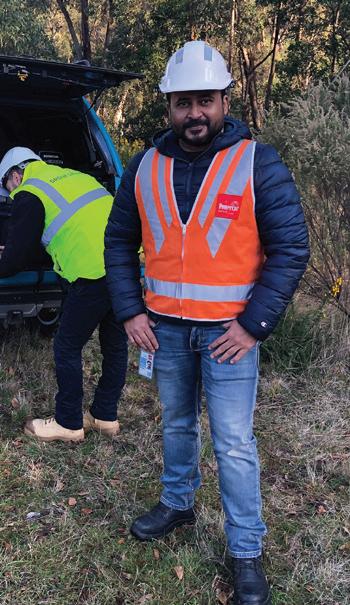
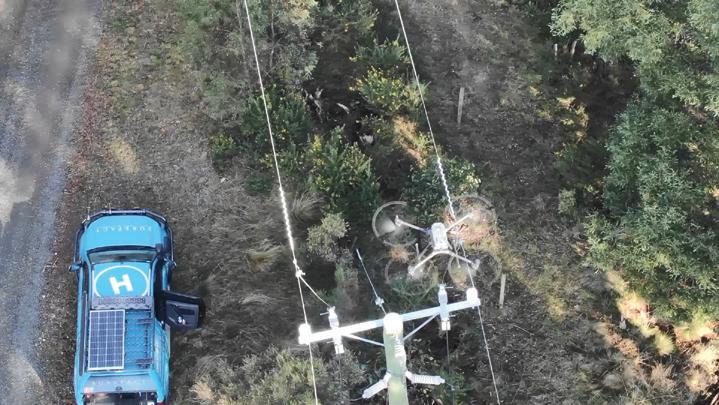
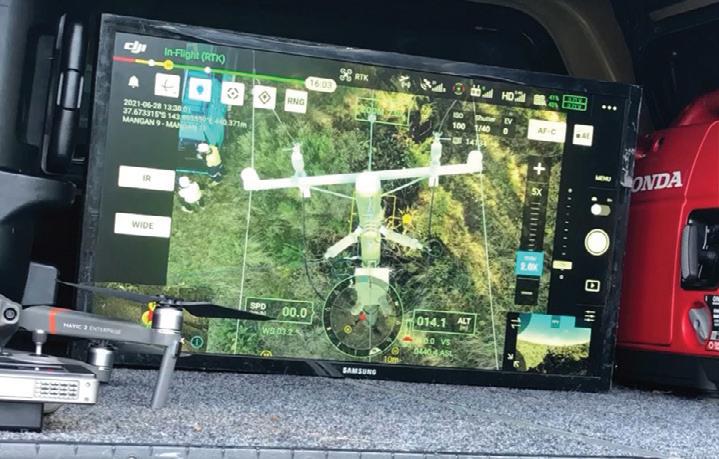
www.energymagazine.com.au September 2021 ISSUE 15
63 DRONES
Program Manager Zesh Ahmer at the site of the trial south of Ballarat.
64 September 2021 ISSUE 15 www.energymagazine.com.au MAJOR FEATURES Grid integration and stabilisation Disruption Embedded networks Biofuels SPECIAL FOCUS Electric vehicles IoT & cloud communication Demand management EQUIPMENT & MACHINERY Switchgear November 2021 Deadline: 15 October 2021 FEATURES SCHEDULE
Antaisolar Australia 4 Australian Private Networks 45 Energy Networks Australia ................................................................................................................................................. IBC Logsys Power Services 51 Pacific Green Technologies ................................................................................................................................................... 41 R&J Batteries ...................................................................................................................................................................... 29 Resourceco 19 RT Health Fund ..................................................................................................................................................................... 7 Siemens Energy IFC Soltec.............................................................................................................................................................................. OBC Zinfra ................................................................................................................................................................................. 36 ADVERTISERS’ INDEX MAJOR FEATURES Energy networks Storage and solar Safety and risk management Waste-to-energy SPECIAL FOCUS Automation Asset management Industrial energy EQUIPMENT & MACHINERY Transformers and substations Vegetation management MAJOR FEATURES Solar Domestic gas outlook Hydrogen and future fuels SPECIAL FOCUS Smart networks Consumer and industrial retail Security EQUIPMENT & MACHINERY Spatial & GIS MAJOR FEATURES Wind Nuclear energy Gas pipelines Energy efficiency SPECIAL FOCUS Microgrids Disaster management Distributed generation EQUIPMENT & MACHINERY Asset inspection & drones/UAVs September 2022 Deadline: 22 July 2022 June 2022 Deadline: 29 April 2022 March 2022 Deadline: 4 February 2022
FEATURES SCHEDULE
Brisbane Convention & Exhibition Centre
KEYNOTE SPEAKERS
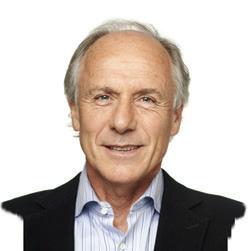


Dr Alan Finkel AO
Special Adviser to the Australian Government on Low Emissions Technology Chair of the Australian Government’s Technology Investment Advisory Council
Dermot Nolan Former CEO, OFGEM UK
Distinguished Professor
Genevieve Bell AO Director, School of Cybernetics, ANU
www.EN2021.com.au
RESEARCH PARTNER PRINCIPAL SPONSOR

The 1P Tracker by Soltec
soltec.com PATENT PENDING





















































 by Chris Gilbert, Energy Networks Australia, Senior Economic Advisor
by Chris Gilbert, Energy Networks Australia, Senior Economic Advisor








































































 Tby Rob Wheals, CEO and Managing Director, APA Group
Tby Rob Wheals, CEO and Managing Director, APA Group





























 by Charlie Richardson, Growth Markets Utilities Lead at Accenture and Soon-Wai Lim, Technology Senior Manager, Accenture ANZ
by Charlie Richardson, Growth Markets Utilities Lead at Accenture and Soon-Wai Lim, Technology Senior Manager, Accenture ANZ









